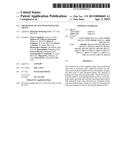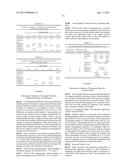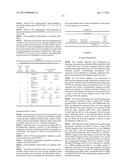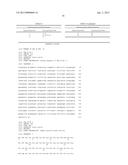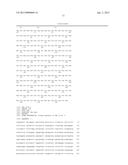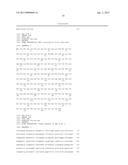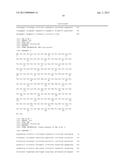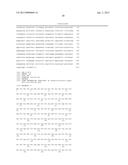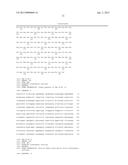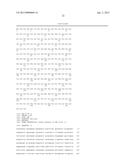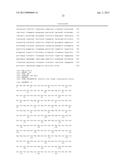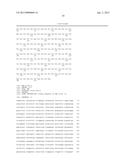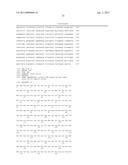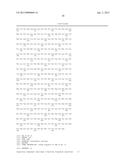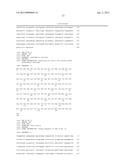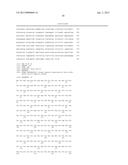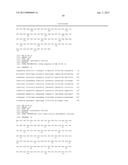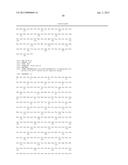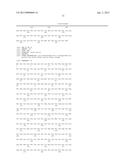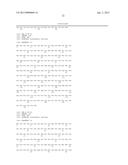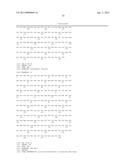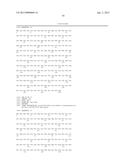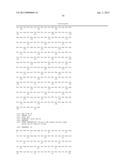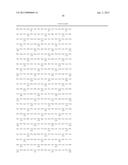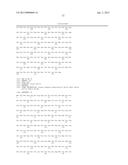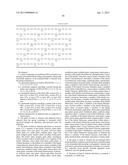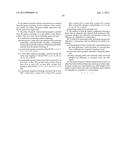Patent application title: Transgenic Plants With Enhanced Traits
Inventors:
Paolo Castiglioni (Davis, CA, US)
Paolo Castiglioni (Davis, CA, US)
Jaishree M. Chittoor-Vijayanath (Wildwood, MO, US)
Jaishree M. Chittoor-Vijayanath (Wildwood, MO, US)
Barry S. Goldman (St. Louis, MO, US)
Robert J. Meister (St. Peters, MO, US)
Robert J. Meister (St. Peters, MO, US)
Monnanda S. Rajani (Chesterfield, MO, US)
G. Ramamohan (Bangalore, IN)
Naveen Silvester (Bangalore, IN)
Tyamagondlu V. Venkatesh (St. Louis, MO, US)
Tyamagondlu V. Venkatesh (St. Louis, MO, US)
Jingrui Wu (Johnston, IA, US)
Jingrui Wu (Johnston, IA, US)
Xiaoyun Wu (Chesterfield, MO, US)
Xiaoyun Wu (Chesterfield, MO, US)
IPC8 Class: AC12N1582FI
USPC Class:
800260
Class name: Multicellular living organisms and unmodified parts thereof and related processes method of using a plant or plant part in a breeding process which includes a step of sexual hybridization
Publication date: 2015-04-02
Patent application number: 20150096069
Abstract:
This disclosure provides transgenic plants having enhanced traits such as
increased yield, enhanced nitrogen use efficiency and enhanced drought
tolerance; propagules, progeny and field crops of such transgenic plants;
and methods of making and using such transgenic plants. This disclosure
also provides methods of producing hybrid seed from such transgenic
plants, growing such seed and selecting progeny plants with enhanced
traits. Also disclosed are transgenic plants with altered phenotypes
which are useful for screening and selecting transgenic events for the
desired enhanced trait.Claims:
1. A plant comprising a recombinant DNA molecule comprising a
polynucleotide encoding a polypeptide, wherein the nucleotide sequence of
the polynucleotide is selected from the group consisting of: a) a
nucleotide sequence set forth as SEQ ID NO: 1, 3, 5, 7, 9, 11, 13, 15,
17, or 19; b) a nucleotide sequence encoding a protein having the amino
acid sequence of SEQ ID NO: 2, 4, 6, 8, 10, 12, 14, 16, 18, or 20-29; c)
a nucleotide sequence with at least 90%, at least 91%, at least 92%, at
least 93%, at least 94%, at least 95%, at least 96%, at least 97%, at
least 98%, at least 99% identity to SEQ ID NO: 1, 3, 5, 7, 9, 11, 13, 15,
17, or 19; and d) a nucleotide sequence encoding a protein with at least
90%, at least 91%, at least 92%, at least 93%, at least 94%, at least
95%, at least 96%, at least 97%, at least 98%, at least 99% identity to
SEQ ID NO: 2, 4, 6, 8, 10, 12, 14, 16, 18, or 20-29; wherein said plant
has an enhanced trait as compared to a control plant.
2. The plant of claim 1, wherein said enhanced trait is selected from the group consisting of increased yield, increased nitrogen use efficiency, and increased water use efficiency.
3. The plant of claim 1, wherein said plant is a monocot plant or is a member of the family Poaceae, wheat plant, maize plant, sweet corn plant, rice plant, wild rice plant, barley plant, rye, millet plant, sorghum plant, sugar cane plant, turfgrass plant, bamboo plant, oat plant, brome-grass plant, Miscanthus plant, pampas grass plant, switchgrass (Panicum) plant, and/or teosinte plant, or is a member of the family Alliaceae, onion plant, leek plant, garlic plant; or wherein the plant is a dicot plant or is a member of the family Amaranthaceae, spinach plant, quinoa plant, a member of the family Anacardiaceae, mango plant, a member of the family Asteraceae, sunflower plant, endive plant, lettuce plant, artichoke plant, a member of the family Brassicaceae, Arabidopsis thaliana plant, rape plant, oilseed rape plant, broccoli plant, Brussels sprouts plant, cabbage plant, canola plant, cauliflower plant, kohlrabi plant, turnip plant, radish plant, a member of the family Bromeliaceae, pineapple plant, a member of the family Caricaceae, papaya plant, a member of the family Chenopodiaceae, beet plant, a member of the family Curcurbitaceae, melon plant, cantaloupe plant, squash plant, watermelon plant, honeydew plant, cucumber plant, pumpkin plant, a member of the family Dioscoreaceae, yam plant, a member of the family Ericaceae, blueberry plant, a member of the family Euphorbiaceae, cassava plant, a member of the family Fabaceae, alfalfa plant, clover plant, peanut plant, a member of the family Grossulariaceae, currant plant, a member of the family Juglandaceae, walnut plant, a member of the family Lamiaceae, mint plant, a member of the family Lauraceae, avocado plant, a member of the family Leguminosae, soybean plant, bean plant, pea plant, a member of the family Malvaceae, cotton plant, a member of the family Marantaceae, arrowroot plant, a member of the family Myrtaceae, guava plant, eucalyptus plant, a member of the family Rosaceae, peach plant, apple plant, cherry plant, plum plant, pear plant, prune plant, blackberry plant, raspberry plant, strawberry plant, a member of the family Rubiaceae, coffee plant, a member of the family Rutaceae, citrus plant, orange plant, lemon plant, grapefruit plant, tangerine plant, a member of the family Salicaceae, poplar plant, willow plant, a member of the family Solanaceae, potato plant, sweet potato plant, tomato plant, Capsicum plant, tobacco plant, tomatillo plant, eggplant plant, Atropa belladona plant, Datura stramonium plant, a member of the family Vitaceae, grape plant, a member of the family Umbelliferae, carrot plant, or a member of the family Musaceae, banana plant; or wherein the plant is a member of the family Pinaceae, cedar plant, fir plant, hemlock plant, larch plant, pine plant, or spruce plant.
4. The plant of claim 1, wherein the recombinant DNA molecule further comprises a promoter that is operably linked to the polynucleotide encoding a polypeptide, wherein said promoter is selected from the group consisting of a constitutive, inducible, tissue specific, diurnally regulated, tissue enhanced, and cell specific promoter.
5. The plant of claim 1, wherein said plant is a progeny, a propagule, or a field crop.
6. The plant of claim 5, wherein said field crop is selected from the group consisting of corn, soybean, cotton, canola, rice, barley, oat, wheat, turf grass, alfalfa, sugar beet, sunflower, quinoa and sugar cane.
7. The plant of claim 5, wherein said propagule is selected from the group consisting of a cell, pollen, ovule, flower, embryo, leaf, root, stem, shoot, meristem, grain and seed.
8. A method for producing a plant comprising: introducing into a plant cell a recombinant DNA molecule comprising a polynucleotide encoding a polypeptide, wherein the nucleotide sequence of the polynucleotide is selected from the group consisting of: a) a nucleotide sequence set forth as SEQ ID NO: 1, 3, 5, 7, 9, 11, 13, 15, 17, or 19; b) a nucleotide sequence encoding a protein having the amino acid sequence of SEQ ID NO: 2, 4, 6, 8, 10, 12, 14, 16, 18, or 20-29; c) a nucleotide sequence with at least 90%, at least 91%, at least 92%, at least 93%, at least 94%, at least 95%, at least 96%, at least 97%, at least 98%, at least 99% identity to SEQ ID NO: 1, 3, 5, 7, 9, 11, 13, 15, 17, or 19; and d) a nucleotide sequence encoding a protein with at least 90%, at least 91%, at least 92%, at least 93%, at least 94%, at least 95%, at least 96%, at least 97%, at least 98%, at least 99% identity to SEQ ID NO: 2, 4, 6, 8, 10, 12, 14, 16, 18, or 20-29; and growing a plant from said plant cell.
9. The method of claim 8, further comprising selecting a plant with an enhanced trait selected from increased yield, increased nitrogen use efficiency, and increased water use efficiency as compared to a control plant.
10. A method for increasing yield, increasing nitrogen use efficiency, or increasing water use efficiency in a plant comprising: crossing the plant of claim 1 with itself, a second plant from the same plant line, a wild type plant, or a second plant from a different line of plants to produce a seed; growing said seed to produce a plurality of progeny plants; and selecting a progeny plant with increased yield, increased nitrogen use efficiency, or increased water use efficiency.
11. The plant of claim 1, wherein said plant has at least one phenotype selected from the group consisting of anthocyanin, biomass, canopy area, chlorophyll score, plant height, water applied, water content and water use efficiency that is altered for said plant as compared to a control plant.
Description:
CROSS REFERENCE TO RELATED APPLICATIONS
[0001] This application claims the benefit under 35 USC §119(e) of U.S. provisional application Ser. No. 61/635,946, filed on Apr. 20, 2012, and is herein incorporated by reference in its entirety.
INCORPORATION OF SEQUENCE LISTING
[0002] The sequence listing file named "38-21(58904)0001_SeqListing.txt", which is 64,196 bytes (measured in MS-WINDOWS) and was created on Mar. 5, 2013, is electronically filed herewith and incorporated herein by reference in its entirety.
FIELD OF THE INVENTION
[0003] Disclosed herein are plants having enhanced traits such as increased yield, increased nitrogen use efficiency and increased water use efficiency; propagules, progenies and field crops of such plants; and methods of making and using such plants. Also disclosed are methods of producing seed from such plants, growing such seed and/or selecting progeny plants with enhanced traits.
SUMMARY OF THE INVENTION
[0004] An aspect of this disclosure provides a plant comprising a recombinant DNA molecule comprising a polynucleotide encoding a polypeptide, wherein the nucleotide sequence of the polynucleotide is selected from the group consisting of: a) a nucleotide sequence set forth as SEQ ID NO: 1, 3, 5, 7, 9, 11, 13, 15, 17, or 19; b) a nucleotide sequence encoding a protein having the amino acid sequence of SEQ ID NO: 2, 4, 6, 8, 10, 12, 14, 16, 18, or 20-29; c) a nucleotide sequence with at least 90%, at least 91%, at least 92%, at least 93%, at least 94%, at least 95%, at least 96%, at least 97%, at least 98%, at least 99% identity to SEQ ID NO: 1, 3, 5, 7, 9, 11, 13, 15, 17, or 19; and d) a nucleotide sequence encoding a protein with at least 90%, at least 91%, at least 92%, at least 93%, at least 94%, at least 95%, at least 96%, at least 97%, at least 98%, at least 99% identity to SEQ ID NO: 2, 4, 6, 8, 10, 12, 14, 16, 18, or 20-29; wherein said plant has enhanced trait as compared to a control plant, and wherein said enhanced trait is selected from the group consisting of increased yield, increased nitrogen use efficiency, and increased water use efficiency.
[0005] Another aspect of this disclosure provides a plant comprising a recombinant DNA molecule of the disclosure, wherein said plant is a monocot plant or is a member of the family Poaceae, wheat plant, maize plant, sweet corn plant, rice plant, wild rice plant, barley plant, rye, millet plant, sorghum plant, sugar cane plant, turfgrass plant, bamboo plant, oat plant, brome-grass plant, Miscanthus plant, pampas grass plant, switchgrass (Panicum) plant, and/or teosinte plant, or is a member of the family Alliaceae, onion plant, leek plant, garlic plant; or wherein the plant is a dicot plant or is a member of the family Amaranthaceae, spinach plant, quinoa plant, a member of the family Anacardiaceae, mango plant, a member of the family Asteraceae, sunflower plant, endive plant, lettuce plant, artichoke plant, a member of the family Brassicaceae, Arabidopsis thaliana plant, rape plant, oilseed rape plant, broccoli plant, Brussels sprouts plant, cabbage plant, canola plant, cauliflower plant, kohlrabi plant, turnip plant, radish plant, a member of the family Bromeliaceae, pineapple plant, a member of the family Caricaceae, papaya plant, a member of the family Chenopodiaceae, beet plant, a member of the family Curcurbitaceae, melon plant, cantaloupe plant, squash plant, watermelon plant, honeydew plant, cucumber plant, pumpkin plant, a member of the family Dioscoreaceae, yam plant, a member of the family Ericaceae, blueberry plant, a member of the family Euphorbiaceae, cassava plant, a member of the family Fabaceae, alfalfa plant, clover plant, peanut plant, a member of the family Grossulariaceae, currant plant, a member of the family Juglandaceae, walnut plant, a member of the family Lamiaceae, mint plant, a member of the family Lauraceae, avocado plant, a member of the family Leguminosae, soybean plant, bean plant, pea plant, a member of the family Malvaceae, cotton plant, a member of the family Marantaceae, arrowroot plant, a member of the family Myrtaceae, guava plant, eucalyptus plant, a member of the family Rosaceae, peach plant, apple plant, cherry plant, plum plant, pear plant, prune plant, blackberry plant, raspberry plant, strawberry plant, a member of the family Rubiaceae, coffee plant, a member of the family Rutaceae, citrus plant, orange plant, lemon plant, grapefruit plant, tangerine plant, a member of the family Salicaceae, poplar plant, willow plant, a member of the family Solanaceae, potato plant, sweet potato plant, tomato plant, Capsicum plant, tobacco plant, tomatillo plant, eggplant plant, Atropa belladona plant, Datura stramonium plant, a member of the family Vitaceae, grape plant, a member of the family Umbelliferae, carrot plant, or a member of the family Musaceae, banana plant; or wherein the plant is a member of the family Pinaceae, cedar plant, fir plant, hemlock plant, larch plant, pine plant, or spruce plant.
[0006] Another aspect of this disclosure provides a plant comprising a recombinant DNA molecule of the disclosure, wherein the recombinant DNA molecule further comprises a promoter that is operably linked to the polynucleotide encoding a polypeptide, wherein said promoter is selected from the group consisting of a constitutive, inducible, tissue specific, diurnally regulated, tissue enhanced, and cell specific promoter.
[0007] Another aspect of this disclosure provides a plant comprising a recombinant DNA molecule of the disclosure, wherein said plant is a progeny, propagule, or field crop. Such field crop is selected from the group consisting of corn, soybean, cotton, canola, rice, barley, oat, wheat, turf grass, alfalfa, sugar beet, sunflower, quinoa and sugar cane.
[0008] Another aspect of this disclosure provides a plant comprising a recombinant DNA molecule of the disclosure, wherein said plant is a progeny, propagule, or field crop. Such propagule is selected from the group consisting of a cell, pollen, ovule, flower, embryo, leaf, root, stem, shoot, meristem, grain and seed.
[0009] Another aspect of this disclosure provides a method of producing a plant comprising: introducing into a plant cell a recombinant DNA comprising a polynucleotide encoding a polypeptide, wherein the nucleotide sequence of the polynucleotide is selected from the group consisting of: a) a nucleotide sequence set forth as SEQ ID NO: 1, 3, 5, 7, 9, 11, 13, 15, 17, or 19; b) a nucleotide sequence encoding a protein having the amino acid sequence of SEQ ID NO: 2, 4, 6, 8, 10, 12, 14, 16, 18, or 20-29; c) a nucleotide sequence with at least 90%, at least 91%, at least 92%, at least 93%, at least 94%, at least 95%, at least 96%, at least 97%, at least 98%, at least 99% identity to SEQ ID NO: 1, 3, 5, 7, 9, 11, 13, 15, 17, or 19; and d) a nucleotide sequence encoding a protein with at least 90%, at least 91%, at least 92%, at least 93%, at least 94%, at least 95%, at least 96%, at least 97%, at least 98%, at least 99% identity to SEQ ID NO: 2, 4, 6, 8, 10, 12, 14, 16, 18, or 20-29; and growing a plant from said plant cell.
[0010] Another aspect of this disclosure provides a method of producing a plant comprising: introducing into a plant cell a recombinant DNA molecule of the disclosure; growing a plant from said plant cell; and selecting a plant with an enhanced trait selected from increased yield, increased nitrogen use efficiency, and increased water use efficiency as compared to a control plant.
[0011] Another aspect of this disclosure provides a method of increasing yield, increasing nitrogen use efficiency, or increasing water use efficiency in a plant comprising: producing a plant comprising a recombinant DNA of the disclosure wherein said plant has an enhanced trait selected from the group consisting of increased yield, increased nitrogen use efficiency, and increased water use efficiency as compared to a control plant; crossing said plant with itself, a second plant from the same plant line, a wild type plant, or a second plant from a different line of plants to produce a seed; growing said seed to produce a plurality of progeny plants, and selecting a progeny plant with increased yield, increased nitrogen use efficiency, or increased water use efficiency.
[0012] Another aspect of this disclosure provides a plant comprising a recombinant DNA molecule comprising a polynucleotide encoding a polypeptide, wherein the nucleotide sequence of the polynucleotide is selected from the group consisting of: a) a nucleotide sequence set forth as SEQ ID NO: 1, 3, 5, 7, 9, 11, 13, 15, 17, or 19; b) a nucleotide sequence encoding a protein having the amino acid sequence of SEQ ID NO: 2, 4, 6, 8, 10, 12, 14, 16, 18, or 20-29; c) a nucleotide sequence with at least 90%, at least 91%, at least 92%, at least 93%, at least 94%, at least 95%, at least 96%, at least 97%, at least 98%, at least 99% identity to SEQ ID NO: 1, 3, 5, 7, 9, 11, 13, 15, 17, or 19; and d) a nucleotide sequence encoding a protein with at least 90%, at least 91%, at least 92%, at least 93%, at least 94%, at least 95%, at least 96%, at least 97%, at least 98%, at least 99% identity to SEQ ID NO: 2, 4, 6, 8, 10, 12, 14, 16, 18, or 20-29; wherein said plant has at least one phenotype selected from the group consisting of anthocyanin, biomass, canopy area, chlorophyll score, plant height, water applied, water content and water use efficiency that is altered for said plant as compared to a control plant.
DETAILED DESCRIPTION OF THE INVENTION
[0013] In the attached sequence listing:
[0014] SEQ ID NOs: 1, 3, 5, 7, 9, 11, 13, 15, 17, and 19 are nucleotide sequences of the coding strand of the DNA molecules used in the recombinant DNA imparting an enhanced trait in plants, each represents a coding sequence for a protein.
[0015] SEQ ID NOs: 2, 4, 6, 8, 10, 12, 14, 16, 18, and 20 are amino acid sequences of the cognate proteins of the DNA molecules with nucleotide sequences 1, 3, 5, 7, 9, 11, 13, 15, 17, and 19.
[0016] SEQ ID NOs: 21-29 are amino acid sequences of homologous proteins.
[0017] As used herein a "plant" includes whole plant, transgenic plant, meritem, shoot organ/structure (for example, leaf, stem and tuber), root, flower and floral organ/structure (for example, bract, sepal, petal, stamen, carpel, anther and ovule), seed (including embryo, endosperm, and seed coat) and fruit (the mature ovary), plant tissue (for example, vascular tissue, ground tissue, and the like) and cell (for example, guard cell, egg cell, pollen, mesophyll cell, and the like), and progeny of same. The classes of plants that can be used in the disclosed methods are generally as broad as the classes of higher and lower plants amenable to transformation and breeding techniques, including angiosperms (monocotyledonous and dicotyledonous plants), gymnosperms, ferns, horsetails, psilophytes, lycophytes, bryophytes, and multicellular algae.
[0018] As used herein a "transgenic plant" means a plant whose genome has been altered by the stable integration of recombinant DNA. A transgenic plant includes a plant regenerated from an originally-transformed plant cell and progeny transgenic plants from later generations or crosses of a transgenic plant.
[0019] As used herein a "control plant" means a plant that does not contain the recombinant DNA that imparts an enhanced trait. A control plant is used to identify and select a transgenic plant that has an enhanced trait. A suitable control plant can be a non-transgenic plant of the parental line used to generate a transgenic plant, for example, a wild type plant devoid of a recombinant DNA. A suitable control plant can also be a transgenic plant that contains the recombinant DNA that imparts other traits, for example, a transgenic plant having enhanced herbicide tolerance. A suitable control plant can in some cases be a progeny of a hemizygous transgenic plant line that does not contain the recombinant DNA, known as a negative segregant, or a negative isoline.
[0020] As used herein a "transgenic plant cell" means a plant cell that is transformed with stably-integrated, recombinant DNA, for example, by Agrobacterium-mediated transformation or by bombardment using microparticles coated with recombinant DNA or by other means. A plant cell of this disclosure can be an originally-transformed plant cell that exists as a microorganism or as a progeny plant cell that is regenerated into differentiated tissue, for example, into a transgenic plant with stably-integrated, recombinant DNA, or seed or pollen derived from a progeny transgenic plant.
[0021] As used herein a "propagule" includes all products of meiosis and mitosis, including but not limited to, plant, seed and part of a plant able to propagate a new plant. Propagules include whole plants, cells, pollen, ovules, flowers, embryos, leaves, roots, stems, shoots, meristems, grains or seeds, or any plant part that is capable of growing into an entire plant. Propagule also includes graft where one portion of a plant is grafted to another portion of a different plant (even one of a different species) to create a living organism. Propagule also includes all plants and seeds produced by cloning or by bringing together meiotic products, or allowing meiotic products to come together to form an embryo or a fertilized egg (naturally or with human intervention).
[0022] As used herein a "progeny" includes any plant, seed, plant cell, and/or regenerable plant part comprising a recombinant DNA of the present disclosure derived from an ancestor plant. A progeny can be homozygous or heterozygous for the transgene. Progeny can be grown from seeds produced by a transgenic plant comprising a recombinant DNA of the present disclosure, and/or from seeds produced by a plant fertilized with pollen or ovule from a transgenic plant comprising a recombinant DNA of the present disclosure.
[0023] As used herein a "trait" is a physiological, morphological, biochemical, or physical characteristic of a plant or particular plant material or cell. In some instances, this characteristic is visible to the human eye, such as seed or plant size, or can be measured by biochemical techniques, such as detecting the protein, starch, certain metabolites, or oil content of seed or leaves, or by observation of a metabolic or physiological process, for example, by measuring tolerance to water deprivation or particular salt or sugar concentrations, or by the measurement of the expression level of a gene or genes, for example--by employing Northern analysis, RT-PCR, microarray gene expression assays, or reporter gene expression systems, or by agricultural observations such as hyperosmotic stress tolerance or yield. Any technique can be used to measure the amount of, comparative level of, or difference in any selected chemical compound or macromolecule in the transgenic plants, however.
[0024] As used herein an "enhanced trait" means a characteristic of a transgenic plant as a result of stable integration and expression of a recombinant DNA in the transgenic plant. Such traits include, but are not limited to, an enhanced agronomic trait characterized by enhanced plant morphology, physiology, growth and development, yield, nutritional enhancement, disease or pest resistance, or environmental or chemical tolerance. In some specific aspects of this disclosure an enhanced trait is selected from the group consisting of drought tolerance, increased water use efficiency, cold tolerance, increased nitrogen use efficiency, increased yield, and altered phenotypes as shown in Tables 3-5. In another aspect of the disclosure the trait is increased yield under non-stress conditions or increased yield under environmental stress conditions. Stress conditions can include, for example, drought, shade, fungal disease, viral disease, bacterial disease, insect infestation, nematode infestation, cold temperature exposure, heat exposure, osmotic stress, reduced nitrogen nutrient availability, reduced phosphorus nutrient availability and high plant density. "Yield" can be affected by many properties including without limitation, plant height, plant biomass, pod number, pod position on the plant, number of internodes, incidence of pod shatter, grain size, efficiency of nodulation and nitrogen fixation, efficiency of nutrient assimilation, resistance to biotic and abiotic stress, carbon assimilation, plant architecture, resistance to lodging, percent seed germination, seedling vigor, and juvenile traits. Yield can also be affected by efficiency of germination (including germination in stressed conditions), growth rate (including growth rate in stressed conditions), ear number, seed number per ear, seed size, composition of seed (starch, oil, protein) and characteristics of seed fill.
[0025] Also used herein, the term "trait modification" encompasses altering the naturally occurring trait by producing a detectable difference in a characteristic in a plant comprising a recombinant DNA encoding a polypeptide of the present disclosure relative to a plant not comprising the recombinant DNA, such as a wild-type plant, or a negative segregant. In some cases, the trait modification can be evaluated quantitatively. For example, the trait modification can entail an increase or decrease, in an observed trait as compared to a control plant. It is known that there can be natural variations in the modified trait. Therefore, the trait modification observed entails a change of the normal distribution and magnitude of the trait in the plants as compared to a control plant.
[0026] Increased yield of a plant of the present disclosure can be measured in a number of ways, including test weight, seed number per plant, seed weight, seed number per unit area (for example, seeds, or weight of seeds, per acre), bushels per acre, tons per acre, or kilo per hectare. For example, corn yield can be measured as production of shelled corn kernels per unit of production area, for example in bushels per acre or metric tons per hectare. This is often also reported on a moisture adjusted basis, for example at 15.5 percent moisture. Increased yield can result from improved utilization of key biochemical compounds, such as nitrogen, phosphorous and carbohydrate, or from improved responses to environmental stresses, such as cold, heat, drought, salt, shade, high plant density, and attack by pests or pathogens. This disclosure can also be used to provide plants with improved growth and development, and ultimately increased yield, as the result of modified expression of plant growth regulators or modification of cell cycle or photosynthesis pathways. Also of interest is the generation of plants that demonstrate increased yield with respect to a seed component that may or may not correspond to an increase in overall plant yield.
[0027] The present disclosure relates to a plant with improved economically important characteristics, more specifically increased yield. More specifically the present disclosure relates to a plant comprising a polynucleotide of this disclosure that encodes a polypeptide, wherein the plant has increased yield as compared to a control plant. Many plants of this disclosure exhibited increased yield as compared to a control plant. In an embodiment, a plant of the present disclosure exhibited an improved trait that is a component of yield.
[0028] The present disclosure relates to a plant with improved economically important characteristics, more specifically increased yield. More specifically the present disclosure relates to a plant comprising a polynucleotide of this disclosure that encodes a polypeptide, wherein the plant has increased yield as compared to a control plant. Many plants of this disclosure exhibited increased yield as compared to a control plant. In an embodiment, a plant of the present disclosure exhibited an improved trait that is a component of yield.
[0029] Reference herein to an increase in yield-related traits can also be taken to mean an increase in biomass (weight) of one or more parts of a plant, which can include above ground and/or below ground (harvestable) plant parts. In particular, such harvestable parts are seeds, and performance of the methods of the disclosure results in plants with increased yield and in particular increased seed yield relative to the seed yield of suitable control plants. The term "yield" of a plant can relate to vegetative biomass (root and/or shoot biomass), to reproductive organs, and/or to propagules (such as seeds) of that plant.
[0030] In an embodiment, "alfalfa yield" can also be measured in forage yield, the amount of above ground biomass at harvest. Factors leading contributing to increased biomass include increased vegetative growth, branches, nodes and internodes, leaf area, and leaf area index.
[0031] In another embodiment, "canola yield" can also be measured in pod number, number of pods per plant, number of pods per node, number of internodes, incidence of pod shatter, seeds per silique, seed weight per silique, improved seed, oil, or protein composition.
[0032] Additionally, "corn or maize yield" can also be measured as production of shelled corn kernels per unit of production area, ears per acre, number of kernel rows per ear, weight per kernel, ear number, fresh or dry ear biomass (weight), kernel rows per ear and kernels per row.
[0033] In yet another embodiment, "cotton yield" can be measured as bolls per plant, size of bolls, fiber quality, seed cotton yield in g/plant, seed cotton yield in lb/acre, lint yield in lb/acre, and number of bales.
[0034] Specific embodiments for "rice yield" can also include panicles per hill, grain per hill, and filled grains per panicle.
[0035] Still further embodiment for "soybean yield" can also include pods per plant, pods per acre, seeds per plant, seeds per pod, weight per seed, weight per pod, pods per node, number of nodes, and the number of internodes per plant.
[0036] In still further embodiments, "sugarcane yield" can be measured as cane yield (tons per acre; kg/hectare), total recoverable sugar (pounds per ton), and sugar yield (tons/acre).
[0037] In yet still further embodiments, "wheat yield" can include: cereal per unit area, grain number, grain weight, grain size, grains per head, seeds per head, seeds per plant, heads per acre, number of viable tillers per plant, composition of seed (for example, carbohydrates, starch, oil, and protein) and characteristics of seed fill.
[0038] The terms "yield", "seed yield" are defined above for a number of core crops. The terms "increased", "improved", "enhanced" are interchangeable and are defined herein.
[0039] The present disclosure also provides a method for the production of plants having increased yield. Performance of the method gives plants having increased yield. "Increased yield" can manifest as one or more of the following: (i) increased plant biomass (weight) of one or more parts of a plant, particularly aboveground (harvestable) parts, of a plant, increased root biomass (increased number of roots, increased root thickness, increased root length) or increased biomass of any other harvestable part; (ii) increased early vigor, defined herein as an improved seedling aboveground area approximately three weeks post-germination. "Early vigor" refers to active healthy plant growth especially during early stages of plant growth, and can result from increased plant fitness due to, for example, the plants being better adapted to their environment (for example, optimizing the use of energy resources, uptake of nutrients and partitioning carbon allocation between shoot and root). Early vigor in corn, for example, is a combination of the ability of corn seeds to germinate and emerge after planting and the ability of the young corn plants to grow and develop after emergence. Plants having early vigor also show increased seedling survival and better establishment of the crop, which often results in highly uniform fields with the majority of the plants reaching the various stages of development at substantially the same time, which often results in increased yield. Therefore early vigor can be determined by measuring various factors, such as kernel weight, percentage germination, percentage emergence, seedling growth, seedling height, root length, root and shoot biomass, canopy size and color and others; (iii) increased total seed yield, which includes an increase in seed biomass (seed weight) and which can be an increase in the seed weight per plant or on an individual seed basis; increased number of panicles per plant; increased pods, increased number of nodes, increased number of flowers ("florets") per panicle/plant; increased seed fill rate; increased number of filled seeds; increased seed size (length, width, area, perimeter), which can also influence the composition of seeds; increased seed volume, which can also influence the composition of seeds. Increased yield can also result in modified architecture, or can occur because of modified plant architecture; (iv) increased harvest index, which is expressed as a ratio of the yield of harvestable parts, such as seeds, over the total biomass; and (v) increased kernel weight, which is extrapolated from the number of filled seeds counted and their total weight. An increased kernel weight can result from an increased seed size and/or seed weight, an increase in embryo size, endosperm size, aleurone and/or scutellum, or other parts of the seed.
[0040] In one embodiment, increased yield can be increased seed yield, and is selected from one of the following: (i) increased seed weight; (ii) increased number of filled seeds; and (iii) increased harvest index.
[0041] The disclosure also extends to harvestable parts of a plant such as, but not limited to, seeds, leaves, fruits, flowers, bolls, stems, rhizomes, tubers and bulbs. The disclosure furthermore relates to products derived from a harvestable part of such a plant, such as dry pellets, powders, oil, fat and fatty acids, starch or proteins.
[0042] The present disclosure provides a method for increasing "yield" of a plant or "broad acre yield" of a plant or plant part defined as the harvestable plant parts per unit area, for example seeds, or weight of seeds, per acre, pounds per acre, bushels per acre, tones per acre, tons per acre, kilo per hectare.
[0043] This disclosure further provides a method of increasing yield in a plant by producing a plant comprising a polynucleic acid sequence encoding a polypeptide of this disclosure where the plant can be crossed with itself, a second plant from the same plant line, a wild type plant, or a plant from a different line of plants to produce a seed. The seed of the resultant plant can be harvested from fertile plants and be used to grow progeny generations of plant(s) of this disclosure. In addition to direct transformation of a plant with a recombinant DNA, transgenic plants can be prepared by crossing a first plant having a recombinant DNA with a second plant lacking the DNA. For example, recombinant DNA can be introduced into a first plant line that is amenable to transformation to produce a transgenic plant which can be crossed with a second plant line to introgress the recombinant DNA into the second plant line. A transgenic plant with a recombinant DNA having the polynucleotide of this disclosure provides the enhanced trait of increased yield compared to a control plant. Genetic markers associated with recombinant DNA can produce transgenic progeny that is homozygous for the desired recombinant DNA. Progeny plants carrying DNA for both parental traits can be back crossed into a parent line multiple times, for example usually 6 to 8 generations, to produce a progeny plant with substantially the same genotype as the one original transgenic parental line but having the recombinant DNA of the other transgenic parental line. The term "progeny" denotes the offspring of any generation of a parent plant prepared by the methods of this disclosure containing the recombinant polynucleotides as described herein.
[0044] As used herein "nitrogen use efficiency" refers to the processes which lead to an increase in the plant's yield, biomass, vigor, and growth rate per nitrogen unit applied. The processes can include the uptake, assimilation, accumulation, signaling, sensing, retranslocation (within the plant) and use of nitrogen by the plant.
[0045] As used herein "nitrogen limiting conditions" refers to growth conditions or environments that provide less than optimal amounts of nitrogen needed for adequate or successful plant metabolism, growth, reproductive success and/or viability.
[0046] As used herein the "increased nitrogen stress tolerance" refers to the ability of plants to grow, develop, or yield normally, or grow, develop, or yield faster or better when subjected to less than optimal amounts of available/applied nitrogen, or under nitrogen limiting conditions.
[0047] As used herein "increased nitrogen use efficiency" refers to the ability of plants to grow, develop, or yield faster or better than normal when subjected to the same amount of available/applied nitrogen as under normal or standard conditions; ability of plants to grow, develop, or yield normally, or grow, develop, or yield faster or better when subjected to less than optimal amounts of available/applied nitrogen, or under nitrogen limiting conditions.
[0048] Increased plant nitrogen use efficiency can be translated in the field into either harvesting similar quantities of yield, while supplying less nitrogen, or increased yield gained by supplying optimal/sufficient amounts of nitrogen. The increased nitrogen use efficiency can improve plant nitrogen stress tolerance, and can also improve crop quality and biochemical constituents of the seed such as protein yield and oil yield. The terms "increased nitrogen use efficiency", "enhanced nitrogen use efficiency", and "nitrogen stress tolerance" are used inter-changeably in the present disclosure to refer to plants with improved productivity under nitrogen limiting conditions.
[0049] As used herein "water use efficiency" refers to the amount of carbon dioxide assimilated by leaves per unit of water vapor transpired. It constitutes one of the most important traits controlling plant productivity in dry environments. "Drought tolerance" refers to the degree to which a plant is adapted to arid or drought conditions. The physiological responses of plants to a deficit of water include leaf wilting, a reduction in leaf area, leaf abscission, and the stimulation of root growth by directing nutrients to the underground parts of the plants. Plants are more susceptible to drought during flowering and seed development (the reproductive stages), as plant's resources are deviated to support root growth. In addition, abscisic acid (ABA), a plant stress hormone, induces the closure of leaf stomata (microscopic pores involved in gas exchange), thereby reducing water loss through transpiration, and decreasing the rate of photosynthesis. These responses improve the water-use efficiency of the plant on the short term. The terms "increased water use efficiency", "enhanced water use efficiency", and "increased drought tolerance" are used inter-changeably in the present disclosure to refer to plants with improved productivity under water-limiting conditions.
[0050] As used herein "increased water use efficiency" refers to the ability of plants to grow, develop, or yield faster or better than normal when subjected to the same amount of available/applied water as under normal or standard conditions; ability of plants to grow, develop, or yield normally, or grow, develop, or yield faster or better when subjected to reduced amounts of available/applied water (water input) or under conditions of water stress or water deficit stress.
[0051] As used herein "increased drought tolerance" refers to the ability of plants to grow, develop, or yield normally, or grow, develop, or yield faster or better than normal when subjected to reduced amounts of available/applied water and/or under conditions of acute or chronic drought; ability of plants to grow, develop, or yield normally when subjected to reduced amounts of available/applied water (water input) or under conditions of water deficit stress or under conditions of acute or chronic drought.
[0052] As used herein "drought stress" refers to a period of dryness (acute or chronic/prolonged) that results in water deficit and subjects plants to stress and/or damage to plant tissues and/or negatively affects grain/crop yield; a period of dryness (acute or chronic/prolonged) that results in water deficit and/or higher temperatures and subjects plants to stress and/or damage to plant tissues and/or negatively affects grain/crop yield.
[0053] As used herein "water deficit" refers to the conditions or environments that provide less than optimal amounts of water needed for adequate/successful growth and development of plants.
[0054] As used herein "water stress" refers to the conditions or environments that provide improper (either less/insufficient or more/excessive) amounts of water than that needed for adequate/successful growth and development of plants/crops thereby subjecting the plants to stress and/or damage to plant tissues and/or negatively affecting grain/crop yield.
[0055] As used herein "water deficit stress" refers to the conditions or environments that provide less/insufficient amounts of water than that needed for adequate/successful growth and development of plants/crops thereby subjecting the plants to stress and/or damage to plant tissues and/or negatively affecting grain yield.
[0056] As used herein a "polynucleotide" is a nucleic acid molecule comprising a plurality of polymerized nucleotides. A polynucleotide may be referred to as a nucleic acid, oligonucleotide, nucleotide, or any fragment thereof. In many instances, a polynucleotide encodes a polypeptide (or protein) or a domain or fragment thereof. Additionally, a polynucleotide can comprise a promoter, an intron, an enhancer region, a polyadenylation site, a translation initiation site, 5' or 3' untranslated regions, a reporter gene, a selectable marker, a scorable marker, or the like. A polynucleotide can be single-stranded or double-stranded DNA or RNA. A polynucleotide optionally comprises modified bases or a modified backbone. A polynucleotide can be, for example, genomic DNA or RNA, a transcript (such as an mRNA), a cDNA, a PCR product, a cloned DNA, a synthetic DNA or RNA, or the like. A polynucleotide can be combined with carbohydrate(s), lipid(s), protein(s), or other materials to perform a particular activity such as transformation or form a composition such as a peptide nucleic acid (PNA). A polynucleotide can comprise a sequence in either sense or antisense orientations. "Oligonucleotide" is substantially equivalent to the terms amplimer, primer, oligomer, element, target, and probe and is preferably single-stranded.
[0057] As used herein a "recombinant polynucleotide" or "recombinant DNA" is a polynucleotide that is not in its native state, for example, a polynucleotide comprises a series of nucleotides (represented as a nucleotide sequence) not found in nature, or a polynucleotide is in a context other than that in which it is naturally found; for example, separated from polynucleotides with which it typically is in proximity in nature, or adjacent (or contiguous with) polynucleotides with which it typically is not in proximity. The "recombinant polynucleotide" or "recombinant DNA" refers to polynucleotide or DNA which has been genetically engineered and constructed outside of a cell including DNA containing naturally occurring DNA or cDNA or synthetic DNA. For example, the polynucleotide at issue can be cloned into a vector, or otherwise recombined with one or more additional nucleic acids.
[0058] As used herein a "polypeptide" comprises a plurality of consecutive polymerized amino acid residues for example, at least about 15 consecutive polymerized amino acid residues. In many instances, a polypeptide comprises a series of polymerized amino acid residues that is a transcriptional regulator or a domain or portion or fragment thereof. Additionally, the polypeptide can comprise: (i) a localization domain; (ii) an activation domain; (iii) a repression domain; (iv) an oligomerization domain; (v) a protein-protein interaction domain; (vi) a DNA-binding domain; or the like. The polypeptide optionally comprises modified amino acid residues, naturally occurring amino acid residues not encoded by a codon, non-naturally occurring amino acid residues.
[0059] As used herein "protein" refers to a series of amino acids, oligopeptide, peptide, polypeptide or portions thereof whether naturally occurring or synthetic.
[0060] Recombinant DNA constructs are assembled using methods known to persons of ordinary skill in the art and typically comprise a promoter operably linked to DNA, the expression of which provides the enhanced agronomic trait. Other construct components can include additional regulatory elements, such as 5' leaders and introns for enhancing transcription, 3' untranslated regions (such as polyadenylation signals and sites), and DNA for transit or targeting or signal peptides.
[0061] As used herein a "recombinant polypeptide" is a polypeptide produced by translation of a recombinant polynucleotide.
[0062] A "synthetic polypeptide" is a polypeptide created by consecutive polymerization of isolated amino acid residues using methods known in the art.
[0063] An "isolated polypeptide", whether a naturally occurring or a recombinant polypeptide, is more enriched in (or out of) a cell than the polypeptide in its natural state in a wild-type cell, for example, more than about 5% enriched, more than about 10% enriched, or more than about 20%, or more than about 50%, or more, enriched, for example, alternatively denoted: 105%, 110%, 120%, 150% or more, enriched relative to wild type standardized at 100%. Such an enrichment is not the result of a natural response of a wild-type plant. Alternatively, or additionally, the isolated polypeptide is separated from other cellular components with which it is typically associated, for example, by any of the various protein purification methods.
[0064] A "DNA construct" as used in the present disclosure comprises at least one expression cassette having a promoter operable in plant cells and a polynucleotide of the present disclosure encoding a protein or variant of a protein or fragment of a protein that is functionally defined to maintain activity in transgenic host cells including plant cells, plant parts, explants and plants. DNA constructs are made that contain various genetic elements necessary for the expression of noncoding and coding polynucleotides in plants. Promoters, leaders, enhancers, introns, transit or targeting or signal peptides, 3' transcriptional termination regions are genetic elements that can be operably linked in a DNA construct.
[0065] Percent identity describes the extent to which polynucleotides or protein segments are invariant in an alignment of sequences, for example nucleotide sequences or amino acid sequences. An alignment of sequences is created by manually aligning two sequences, for example, a stated sequence, as provided herein, as a reference, and another sequence, to produce the highest number of matching elements, for example, individual nucleotides or amino acids, while allowing for the introduction of gaps into either sequence. An "identity fraction" for a sequence aligned with a reference sequence is the number of matching elements, divided by the full length of the reference sequence, not including gaps introduced by the alignment process into the reference sequence. "Percent identity" ("% identity") as used herein is the identity fraction times 100.
[0066] As used herein, a "functional fragment" refers to a portion of a polypeptide provided herein which retains full or partial molecular, physiological or biochemical function of the full length polypeptide. A functional fragment often contains the domain(s), such as Pfam domains, identified in the polypeptide provided in the sequence listing.
[0067] As used herein, a "homolog" or "homologues" means a protein in a group of proteins that perform the same biological function, for example, proteins that belong to the same Pfam protein family and that provide a common enhanced trait in transgenic plants of this disclosure. Homologs are expressed by homologous genes. With reference to homologous genes, homologs include orthologs, for example, genes expressed in different species that evolved from a common ancestral genes by speciation and encode proteins retain the same function, but do not include paralogs, for example, genes that are related by duplication but have evolved to encode proteins with different functions. Homologous genes include naturally occurring alleles and artificially-created variants. Degeneracy of the genetic code provides the possibility to substitute at least one base of the protein encoding sequence of a gene with a different base without causing the amino acid sequence of the polypeptide produced from the gene to be changed. When optimally aligned, homolog proteins, or their corresponding nucleotide sequences, have typically at least about 60% identity, in some instances at least about 70%, at least about 75%, at least about bout 80%, at least about 85%, at least about 90%, at least about bout 92%, at least about bout 94%, at least about bout 95%, at least about 96%, at least about 97%, at least about 98%, at least about 99%, and even at least about 99.5% identity over the full length of a protein or its corresponding nucleotide sequence identified as being associated with imparting an enhanced trait when expressed in plant cells. In one aspect of the disclosure homolog proteins have an amino acid sequences that have at least about 80%, at least about 85%, at least about 90%, at least about 92%, at least about 94%, at least about 95%, at least about 96%, at least about 97%, at least about 98%, at least about 99%, and at least about 99.5% identity to a consensus amino acid sequence of proteins and homologs that can be built from sequences disclosed herein.
[0068] Homologs are inferred from sequence similarity, by comparison of protein sequences, for example, manually or by use of a computer-based tool using well-known sequence comparison algorithms such as BLAST and FASTA. A sequence search and local alignment program, for example, BLAST, can be used to search query protein sequences of a base organism against a database of protein sequences of various organisms, to find similar sequences, and the summary Expectation value (E-value) can be used to measure the level of sequence similarity. Because a protein hit with the lowest E-value for a particular organism may not necessarily be an ortholog or be the only ortholog, a reciprocal query is used to filter hit sequences with significant E-values for ortholog identification. The reciprocal query entails search of the significant hits against a database of protein sequences of the base organism. A hit can be identified as an ortholog, when the reciprocal query's best hit is the query protein itself or a paralog of the query protein. With the reciprocal query process orthologs are further differentiated from paralogs among all the homologs, which allows for the inference of functional equivalence of genes. A further aspect of the homologs encoded by DNA useful in the transgenic plants of the invention are those proteins that differ from a disclosed protein as the result of deletion or insertion of one or more amino acids in a native sequence.
[0069] Other functional homolog proteins differ in one or more amino acids from those of a trait-improving protein disclosed herein as the result of one or more of the well-known conservative amino acid substitutions, for example, valine is a conservative substitute for alanine and threonine is a conservative substitute for serine. Conservative substitutions for an amino acid within the native sequence can be selected from other members of a class to which the naturally occurring amino acid belongs. Representative amino acids within these various classes include, but are not limited to: (1) acidic (negatively charged) amino acids such as aspartic acid and glutamic acid; (2) basic (positively charged) amino acids such as arginine, histidine, and lysine; (3) neutral polar amino acids such as glycine, serine, threonine, cysteine, tyrosine, asparagine, and glutamine; and (4) neutral nonpolar (hydrophobic) amino acids such as alanine, leucine, isoleucine, valine, proline, phenylalanine, tryptophan, and methionine. Conserved substitutes for an amino acid within a native protein or polypeptide can be selected from other members of the group to which the naturally occurring amino acid belongs. For example, a group of amino acids having aliphatic side chains is glycine, alanine, valine, leucine, and isoleucine; a group of amino acids having aliphatic-hydroxyl side chains is serine and threonine; a group of amino acids having amide-containing side chains is asparagine and glutamine; a group of amino acids having aromatic side chains is phenylalanine, tyrosine, and tryptophan; a group of amino acids having basic side chains is lysine, arginine, and histidine; and a group of amino acids having sulfur-containing side 30 chains is cysteine and methionine. Naturally conservative amino acids substitution groups are: valine-leucine, valine-isoleucine, phenylalanine-tyrosine, lysine-arginine, alaninevaline, aspartic acid-glutamic acid, and asparagine-glutamine. A further aspect of the disclosure includes proteins that differ in one or more amino acids from those of a described protein sequence as the result of deletion or insertion of one or more amino acids in a native sequence.
[0070] In general, the term "variant" refers to molecules with some differences, generated synthetically or naturally, in their nucleotide or amino acid sequences as compared to a reference (native) polynucleotides or polypeptides, respectively. These differences include substitutions, insertions, deletions or any desired combinations of such changes in a native polynucleotide or amino acid sequence.
[0071] With regard to polynucleotide variants, differences between presently disclosed polynucleotides and polynucleotide variants are limited so that the nucleotide sequences of the former and the latter are similar overall and, in many regions, identical. Due to the degeneracy of the genetic code, differences between the former and the latter nucleotide sequences may be silent (for example, the amino acids encoded by the polynucleotide are the same, and the variant polynucleotide sequence encodes the same amino acid sequence as the presently disclosed polynucleotide). Variant nucleotide sequences can encode different amino acid sequences, in which case such nucleotide differences will result in amino acid substitutions, additions, deletions, insertions, truncations or fusions with respect to the similarly disclosed polynucleotide sequences. These variations can result in polynucleotide variants encoding polypeptides that share at least one functional characteristic. The degeneracy of the genetic code also dictates that many different variant polynucleotides can encode identical and/or substantially similar polypeptides.
[0072] As used herein "gene" or "gene sequence" refers to the partial or complete coding sequence of a gene, its complement, and its 5' and/or 3' untranslated regions. A gene is also a functional unit of inheritance, and in physical terms is a particular segment or sequence of nucleotides along a molecule of DNA (or RNA, in the case of RNA viruses) involved in producing a polypeptide chain. The latter can be subjected to subsequent processing such as chemical modification or folding to obtain a functional protein or polypeptide. By way of example, a transcriptional regulator gene encodes a transcriptional regulator polypeptide, which can be functional or require processing to function as an initiator of transcription.
[0073] As used herein, the term "promoter" refers generally to a DNA molecule that is involved in recognition and binding of RNA polymerase II and other proteins (trans-acting transcription factors) to initiate transcription. A promoter can be initially isolated from the 5' untranslated region (5' UTR) of a genomic copy of a gene. Alternately, promoters can be synthetically produced or manipulated DNA molecules. Promoters can also be chimeric, that is a promoter produced through the fusion of two or more heterologous DNA molecules. Plant promoters include promoter DNA obtained from plants, plant viruses, fungi and bacteria such as Agrobacterium and Bradyrhizobium bacteria.
[0074] Promoters which initiate transcription in all or most tissues of the plant are referred to as "constitutive" promoters. Promoters which initiate transcription during certain periods or stages of development are referred to as "developmental" promoters. Promoters whose expression is enhanced in certain tissues of the plant relative to other plant tissues are referred to as "tissue enhanced" or "tissue preferred" promoters. Promoters which express within a specific tissue of the plant, with little or no expression in other plant tissues are referred to as "tissue specific" promoters. A promoter that expresses in a certain cell type of the plant, for example a microspore mother cell, is referred to as a "cell type specific" promoter. An "inducible" promoter is a promoter in which transcription is initiated in response to an environmental stimulus such as cold, drought or light; or other stimuli such as wounding or chemical application. Many physiological and biochemical processes in plants exhibit endogenous rhythms with a period of about 24 hours. A "diurnal promoter" is a promoter which exhibits altered expression profiles under the control of a circadian oscillator. Diurnal regulation is subject to environmental inputs such as light and temperature and coordination by the circadian clock.
[0075] Sufficient expression in plant seed tissues is desired to affect improvements in seed composition. Exemplary promoters for use for seed composition modification include promoters from seed genes such as napin as disclosed in U.S. Pat. No. 5,420,034, maize L3 oleosin as disclosed in U.S. Pat. No. 6,433,252, zein Z27 as disclosed by Russell et al. (1997) Transgenic Res. 6(2):157-166, globulin 1 as disclosed by Belanger et al (1991) Genetics 129:863-872, glutelin 1 as disclosed by Russell (1997) supra, and peroxiredoxin antioxidant (Peri) as disclosed by Stacy et al. (1996) Plant Mol Biol. 31(6):1205-1216.
[0076] As used herein, the term "leader" refers to a DNA molecule isolated from the untranslated 5' region (5' UTR) of a genomic copy of a gene and is defined generally as a nucleotide segment between the transcription start site (TSS) and the protein coding sequence start site. Alternately, leaders can be synthetically produced or manipulated DNA elements. A leader can be used as a 5' regulatory element for modulating expression of an operably linked transcribable polynucleotide molecule.
[0077] As used herein, the term "intron" refers to a DNA molecule that can be isolated or identified from the genomic copy of a gene and can be defined generally as a region spliced out during mRNA processing prior to translation. Alternately, an intron can be a synthetically produced or manipulated DNA element. An intron can contain enhancer elements that effect the transcription of operably linked genes. An intron can be used as a regulatory element for modulating expression of an operably linked transcribable polynucleotide molecule. A DNA construct can comprise an intron, and the intron may or may not be heterologous with respect to the transcribable polynucleotide molecule.
[0078] As used herein, the term "enhancer" or "enhancer element" refers to a cis-acting transcriptional regulatory element, a.k.a. cis-element, which confers an aspect of the overall expression pattern, but is usually insufficient alone to drive transcription, of an operably linked polynucleotide. Unlike promoters, enhancer elements do not usually include a transcription start site (TSS) or TATA box or equivalent sequence. A promoter can naturally comprise one or more enhancer elements that affect the transcription of an operably linked polynucleotide. An isolated enhancer element can also be fused to a promoter to produce a chimeric promoter cis-element, which confers an aspect of the overall modulation of gene expression. A promoter or promoter fragment can comprise one or more enhancer elements that effect the transcription of operably linked genes. Many promoter enhancer elements are believed to bind DNA-binding proteins and/or affect DNA topology, producing local conformations that selectively allow or restrict access of RNA polymerase to the DNA template or that facilitate selective opening of the double helix at the site of transcriptional initiation. An enhancer element can function to bind transcription factors that regulate transcription. Some enhancer elements bind more than one transcription factor, and transcription factors can interact with different affinities with more than one enhancer domain.
[0079] Expression cassettes of this disclosure can include a "transit peptide" or "targeting peptide" or "signal peptide" molecule located either 5' or 3' to or within the gene(s). These terms generally refer to peptide molecules that when linked to a protein of interest directs the protein to a particular tissue, cell, subcellular location, or cell organelle. Examples include, but are not limited to, chloroplast transit peptides (CTPs), chloroplast targeting peptides, mitochondrial targeting peptides, nuclear targeting signals, nuclear exporting signals, vacuolar targeting peptides, vacuolar sorting peptides. For description of the use of chloroplast transit peptides see U.S. Pat. No. 5,188,642 and U.S. Pat. No. 5,728,925. For description of the transit peptide region of an Arabidopsis EPSPS gene in the present disclosure, see Klee, H. J. et al (MGG (1987) 210:437-442. Expression cassettes of this disclosure can also include an intron or introns. Expression cassettes of this disclosure can contain a DNA near the 3' end of the cassette that acts as a signal to terminate transcription from a heterologous nucleic acid and that directs polyadenylation of the resultant mRNA. These are commonly referred to as "3'-untranslated regions" or "3'-non-coding sequences" or "3'-UTRs". The "3' non-translated sequences" means DNA sequences located downstream of a structural nucleotide sequence and include sequences encoding polyadenylation and other regulatory signals capable of affecting mRNA processing or gene expression. The polyadenylation signal functions in plants to cause the addition of polyadenylate nucleotides to the 3' end of the mRNA precursor. The polyadenylation signal can be derived from a natural gene, from a variety of plant genes, or from T-DNA. An example of a polyadenylation sequence is the nopaline synthase 3' sequence (nos 3'; Fraley et al., Proc. Natl. Acad. Sci. USA 80: 4803-4807, 1983). The use of different 3' non-translated sequences is exemplified by Ingelbrecht et al., Plant Cell 1:671-680, 1989.
[0080] Expression cassettes of this disclosure can also contain one or more genes that encode selectable markers and confer resistance to a selective agent such as an antibiotic or a herbicide. A number of selectable marker genes are known in the art and can be used in the present disclosure: selectable marker genes conferring tolerance to antibiotics like kanamycin and paromomycin (nptII), hygromycin B (aph IV), spectinomycin (aadA), U.S. Patent Publication 2009/0138985A1 and gentamycin (aac3 and aacC4) or tolerance to herbicides like glyphosate (for example, 5-enolpyruvylshikimate-3-phosphate synthase (EPSPS), U.S. Pat. No. 5,627,061; U.S. Pat. No. 5,633,435; U.S. Pat. No. 6,040,497; U.S. Pat. No. 5,094,945), sulfonyl herbicides (for example, acetohydroxyacid synthase or acetolactate synthase conferring tolerance to acetolactate synthase inhibitors such as sulfonylurea, imidazolinone, triazolopyrimidine, pyrimidyloxybenzoates and phthalide (U.S. Pat. Nos. 6,225,105; 5,767,366; 4,761,373; 5,633,437; 6,613,963; 5,013,659; 5,141,870; 5,378,824; 5,605,011)), bialaphos or phosphinothricin or derivatives (e.g., phosphinothricin acetyltransferase (bar) tolerance to phosphinothricin or glufosinate (U.S. Pat. Nos. 5,646,024; 5,561,236; 5,276,268; 5,637,489; 5,273,894); dicamba (dicamba monooxygenase, Patent Application Publications US2003/0115626A1), or sethoxydim (modified acetyl-coenzyme A carboxylase for conferring tolerance to cyclohexanedione (sethoxydim)), and aryloxyphenoxypropionate (haloxyfop, U.S. Pat. No. 6,414,222).
[0081] Transformation vectors of this disclosure can contain one or more "expression cassettes", each comprising a native or non-native plant promoter operably linked to a polynucleotide sequence of interest, which is operably linked to a 3' UTR termination signal, for expression in an appropriate host cell. It also typically comprises sequences required for proper translation of the polynucleotide or transgene. As used herein, the term "transgene" refers to a polynucleotide molecule artificially incorporated into a host cell's genome. Such a transgene can be heterologous to the host cell. The term "transgenic plant" refers to a plant comprising such a transgene. The coding region usually codes for a protein of interest but can also code for a functional RNA of interest, for example an antisense RNA, a nontranslated RNA, in the sense or antisense direction, a microRNA, a noncoding RNA, or a synthetic RNA used in either suppression or over expression of target gene sequences. The expression cassette comprising the nucleotide sequence of interest can be chimeric, meaning that at least one of its components is heterologous with respect to at least one of its other components. As used herein the term "chimeric" refers to a DNA molecule that is created from two or more genetically diverse sources, for example a first molecule from one gene or organism and a second molecule from another gene or organism.
[0082] Recombinant DNA constructs in this disclosure generally include a 3' element that typically contains a polyadenylation signal and site. Known 3' elements include those from Agrobacterium tumefaciens genes such as nos 3', tml 3', tmr 3', tms 3', ocs 3', tr7 3', for example disclosed in U.S. Pat. No. 6,090,627; 3' elements from plant genes such as wheat (Triticum aesevitum) heat shock protein 17 (Hsp17 3'), a wheat ubiquitin gene, a wheat fructose-1,6-biphosphatase gene, a rice glutelin gene, a rice lactate dehydrogenase gene and a rice beta-tubulin gene, all of which are disclosed in US Patent Application Publication 2002/0192813 A1; and the pea (Pisum sativum) ribulose biphosphate carboxylase gene (rbs 3'), and 3' elements from the genes within the host plant.
[0083] As used herein "operably linked" means the association of two or more DNA fragments in a recombinant DNA construct so that the function of one, for example, protein-encoding DNA, is controlled by the other, for example, a promoter.
[0084] As used herein "expressed" means produced, for example, a protein is expressed in a plant cell when its cognate DNA is transcribed to mRNA that is translated to the protein. An "expressed" protein can also include its truncated version (for example, N-terminal truncated, C-terminal truncated or internal truncated) as long as the truncated version maintains the same or similar functionality as the full length version.
[0085] Transgenic plants can comprise a stack of one or more polynucleotides disclosed herein resulting in the production of multiple polypeptide sequences. Transgenic plants comprising stacks of polynucleotides can be obtained by either or both of traditional breeding methods or through genetic engineering methods. These methods include, but are not limited to, crossing individual transgenic lines each comprising a polynucleotide of interest, transforming a transgenic plant comprising a first gene disclosed herein with a second gene, and co-transformation of genes into a single plant cell. Co-transformation of genes can be carried out using single transformation vectors comprising multiple genes or genes carried separately on multiple vectors.
[0086] Transgenic plants comprising or derived from plant cells of this disclosure transformed with recombinant DNA can be further enhanced with stacked traits, for example, a crop plant having an enhanced trait resulting from expression of DNA disclosed herein in combination with herbicide and/or pest resistance traits. For example, genes of the current disclosure can be stacked with other traits of agronomic interest, such as a trait providing herbicide resistance, or insect resistance, such as using a gene from Bacillus thuringensis to provide resistance against lepidopteran, coliopteran, homopteran, hemiopteran, and other insects, or improved quality traits such as improved nutritional value. Herbicides for which transgenic plant tolerance has been demonstrated and the method of the present disclosure can be applied include, but are not limited to, glyphosate, dicamba, glufosinate, sulfonylurea, bromoxynil and norflurazon herbicides. Polynucleotide molecules encoding proteins involved in herbicide tolerance are well-known in the art and include, but are not limited to, a polynucleotide molecule encoding 5-enolpyruvylshikimate-3-phosphate synthase (EPSPS) disclosed in U.S. Pat. Nos. 5,094,945; 5,627,061; 5,633,435 and 6,040,497 for imparting glyphosate tolerance; polynucleotide molecules encoding a glyphosate oxidoreductase (GOX) disclosed in U.S. Pat. No. 5,463,175 and a glyphosate-N-acetyl transferase (GAT) disclosed in US Patent Application Publication 2003/0083480 A1 also for imparting glyphosate tolerance; dicamba monooxygenase disclosed in US Patent Application Publication 2003/0135879 A1 for imparting dicamba tolerance; a polynucleotide molecule encoding bromoxynil nitrilase (Bxn) disclosed in U.S. Pat. No. 4,810,648 for imparting bromoxynil tolerance; a polynucleotide molecule encoding phytoene desaturase (crtI) described in Misawa et al, (1993) Plant J. 4:833-840 and in Misawa et al, (1994) Plant J. 6:481-489 for norflurazon tolerance; a polynucleotide molecule encoding acetohydroxyacid synthase (AHAS, aka ALS) described in Sathasiivan et al. (1990) Nucl. Acids Res. 18:2188-2193 for imparting tolerance to sulfonylurea herbicides; polynucleotide molecules known as bar genes disclosed in DeBlock, et al. (1987) EMBO J. 6:2513-2519 for imparting glufosinate and bialaphos tolerance; polynucleotide molecules disclosed in US Patent Application Publication 2003/010609 A1 for imparting N-amino methyl phosphonic acid tolerance; polynucleotide molecules disclosed in U.S. Pat. No. 6,107,549 for impartinig pyridine herbicide resistance; molecules and methods for imparting tolerance to multiple herbicides such as glyphosate, atrazine, ALS inhibitors, isoxoflutole and glufosinate herbicides are disclosed in U.S. Pat. No. 6,376,754 and US Patent Application Publication 2002/0112260. Molecules and methods for imparting insect/nematode/virus resistance are disclosed in U.S. Pat. Nos. 5,250,515; 5,880,275; 6,506,599; 5,986,175 and US Patent Application Publication 2003/0150017 A1.
Plant Cell Transformation Methods
[0087] Numerous methods for transforming chromosomes in a plant cell with recombinant DNA are known in the art and are used in methods of producing a transgenic plant cell and plant. Two effective methods for such transformation are Agrobacterium-mediated transformation and microprojectile bombardment-mediated transformation. Microprojectile bombardment methods are illustrated in U.S. Pat. No. 5,015,580 (soybean); U.S. Pat. No. 5,550,318 (corn); U.S. Pat. No. 5,538,880 (corn); U.S. Pat. No. 5,914,451 (soybean); U.S. Pat. No. 6,160,208 (corn); U.S. Pat. No. 6,399,861 (corn); U.S. Pat. No. 6,153,812 (wheat) and U.S. Pat. No. 6,365,807 (rice). Agrobacterium-mediated transformation methods are described in U.S. Pat. No. 5,159,135 (cotton); U.S. Pat. No. 5,824,877 (soybean); U.S. Pat. No. 5,463,174 (canola); U.S. Pat. No. 5,591,616 (corn); U.S. Pat. No. 5,846,797 (cotton); U.S. Pat. No. 6,384,301 (soybean), U.S. Pat. No. 7,026,528 (wheat) and U.S. Pat. No. 6,329,571 (rice), US Patent Application Publication 2004/0087030 A1 (cotton), and US Patent Application Publication 2001/0042257 A1 (sugar beet), all of which are incorporated herein by reference in their entirety. Transformation of plant material is practiced in tissue culture on nutrient media, for example a mixture of nutrients that allow cells to grow in vitro. Recipient cell targets include, but are not limited to, meristem cells, shoot tips, hypocotyls, calli, immature or mature embryos, and gametic cells such as microspores, pollen, sperm and egg cells. Callus can be initiated from tissue sources including, but not limited to, immature or mature embryos, hypocotyls, seedling apical meristems, microspores and the like. Cells containing a transgenic nucleus are grown into transgenic plants.
[0088] In addition to direct transformation of a plant material with a recombinant DNA, a transgenic plant can be prepared by crossing a first plant comprising a recombinant DNA with a second plant lacking the recombinant DNA. For example, recombinant DNA can be introduced into a first plant line that is amenable to transformation, which can be crossed with a second plant line to introgress the recombinant DNA into the second plant line. A transgenic plant with recombinant DNA providing an enhanced trait, for example, enhanced yield, can be crossed with a transgenic plant line having other recombinant DNA that confers another trait, for example herbicide resistance or pest resistance, to produce progeny plants having recombinant DNA that confers both traits. Typically, in such breeding for combining traits the transgenic plant donating the additional trait is a male line and the transgenic plant carrying the base traits is the female line. The progeny of this cross will segregate such that some of the plants will carry the DNA for both parental traits and some will carry DNA for one parental trait; such plants can be identified by markers associated with parental recombinant DNA, for example, marker identification by analysis for recombinant DNA or, in the case where a selectable marker is linked to the recombinant, by application of the selecting agent such as a herbicide for use with a herbicide tolerance marker, or by selection for the enhanced trait. Progeny plants carrying DNA for both parental traits can be crossed back into the female parent line multiple times, for example usually 6 to 8 generations, to produce a progeny plant with substantially the same genotype as the original transgenic parental line but for the recombinant DNA of the other transgenic parental line.
[0089] For transformation, DNA is typically introduced into only a small percentage of target plant cells in any one transformation experiment. Marker genes are used to provide an efficient system for identification of those cells that are stably transformed by receiving and integrating a recombinant DNA molecule into their genomes. Preferred marker genes provide selective markers which confer resistance to a selective agent, such as an antibiotic or a herbicide. Any of the herbicides to which plants of this disclosure can be resistant is a agent for selective markers. Potentially transformed cells are exposed to the selective agent. In the population of surviving cells are those cells where, generally, the resistance-conferring gene is integrated and expressed at sufficient levels to permit cell survival. Cells can be tested further to confirm stable integration of the exogenous DNA. Commonly used selective marker genes include those conferring resistance to antibiotics such as kanamycin and paromomycin (nptII), hygromycin B (aph IV), spectinomycin (aadA) and gentamycin (aac3 and aacC4) or resistance to herbicides such as glufosinate (bar or pat), dicamba (DMO) and glyphosate (aroA or EPSPS). Examples of such selectable markers are illustrated in U.S. Pat. Nos. 5,550,318; 5,633,435; 5,780,708 and 6,118,047. Markers which provide an ability to visually screen transformants can also be employed, for example, a gene expressing a colored or fluorescent protein such as a luciferase or green fluorescent protein (GFP) or a gene expressing a beta-glucuronidase or uidA gene (GUS) for which various chromogenic substrates are known.
[0090] Plant cells that survive exposure to a selective agent, or plant cells that have been scored positive in a screening assay, may be cultured in vitro to regenerate plantlets. Developing plantlets regenerated from transformed plant cells can be transferred to plant growth mix, and hardened off, for example, in an environmentally controlled chamber at about 85% relative humidity, 600 ppm CO2, and 25-250 microeinsteins m-2 s-1 of light, prior to transfer to a greenhouse or growth chamber for maturation. Plants are regenerated from about 6 weeks to 10 months after a transformant is identified, depending on the initial tissue, and plant species. Plants can be pollinated using conventional plant breeding methods known to those of skill in the art to produce seeds, for example self-pollination is commonly used with transgenic corn. The regenerated transformed plant or its progeny seed or plants can be tested for expression of the recombinant DNA and selected for the presence of an enhanced agronomic trait.
Transgenic Plants and Seeds
[0091] Transgenic plants derived from transgenic plant cells having a transgenic nucleus of this disclosure are grown to generate transgenic plants having an enhanced trait as compared to a control plant, and produce transgenic seed and haploid pollen of this disclosure. Such plants with enhanced traits are identified by selection of transformed plants or progeny seed for the enhanced trait. For efficiency a selection method is designed to evaluate multiple transgenic plants (events) comprising the recombinant DNA, for example multiple plants from 2 to 20 or more transgenic events. Transgenic plants grown from transgenic seeds provided herein demonstrate improved agronomic traits that contribute to increased yield or other traits that provide increased plant value, including, for example, improved seed quality. Of particular interest are plants having increased water use efficiency or drought tolerance, enhanced high temperature or cold tolerance, increased yield, increased nitrogen use efficiency.
[0092] Table 1 provides a list of protein-encoding DNA ("genes") as recombinant DNA for production of transgenic plants with enhanced traits, the elements of Table 1 are described by reference to:
[0093] "PEP SEQ ID NO" which identifies an amino acid sequence.
[0094] "NUC SEQ ID NO" which identifies a DNA sequence.
[0095] "Gene ID" which refers to an arbitrary identifier.
[0096] "Protein Name" which is a common name for protein encoded by the recombinant DNA.
TABLE-US-00001 TABLE 1 NUC PEP SEQ ID SEQ ID NO NO Gene ID Protein Name 1 2 TRDXM1-1 OsNAC6 protein. 3 4 TRDXM1-2 WRKY transcription factor. 5 6 TRDXM1-3 ERF-like protein 7 8 TRDXM1-4 PREDICTED: E3 ubiquitin- protein ligase ATL6-like. 9 10 TRDXM1-5 Putative bHLH transcription factor. 11 12 TRDXM1-6 Putative zinc finger transcription factor 13 14 TRDXM1-7 Putative DNA repair protein rhp54. 15 16 TRDXM1-8 Transcription factor-like protein bZIP1. 17 18 TRDXM1-9 Stress-induced transcription factor NAC1. 19 20 TRDXM1-10 Zinc finger protein.
Selection Methods for Transgenic Plants with Enhanced Traits
[0097] Within a population of transgenic plants each regenerated from a plant cell with recombinant DNA many plants that survive to fertile transgenic plants that produce seeds and progeny plants will not exhibit an enhanced agronomic trait. Selection from the population is necessary to identify one or more transgenic plants with an enhanced trait. Transgenic plants having enhanced traits are selected from populations of plants regenerated or derived from plant cells transformed as described herein by evaluating the plants in a variety of assays to detect an enhanced trait, for example, increased water use efficiency or drought tolerance, enhanced high temperature or cold tolerance, increased yield, increased nitrogen use efficiency, enhanced seed composition such as enhanced seed protein and enhanced seed oil. These assays can take many forms including, but not limited to, direct screening for the trait in a greenhouse or field trial or by screening for a surrogate trait. Such analyses can be directed to detecting changes in the chemical composition, biomass, physiological property, or morphology of the plant. Changes in chemical compositions such as nutritional composition of grain can be detected by analysis of the seed composition and content of protein, free amino acids, oil, free fatty acids, starch or tocopherols. Changes in chemical compositions can also be detected by analysis of contents in leaves, such as chlorophyll or carotenoid contents. Changes in biomass characteristics can be evaluated on greenhouse or field grown plants and can include plant height, stem diameter, root and shoot dry weights, canopy size; and, for corn plants, ear length and diameter. Changes in physiological properties can be identified by evaluating responses to stress conditions, for example assays using imposed stress conditions such as water deficit, nitrogen deficiency, cold growing conditions, pathogen or insect attack or light deficiency, or increased plant density. Changes in morphology can be measured by visual observation of tendency of a transformed plant to appear to be a normal plant as compared to changes toward bushy, taller, thicker, narrower leaves, striped leaves, knotted trait, chlorosis, albino, anthocyanin production, or altered tassels, ears or roots. Other selection properties include days to pollen shed, days to silking, leaf extension rate, chlorophyll content, leaf temperature, stand, seedling vigor, internode length, plant height, leaf number, leaf area, tillering, brace roots, stay green or deleyed senescence, stalk lodging, root lodging, plant health, barreness/prolificacy, green snap, and pest resistance. In addition, phenotypic characteristics of harvested grain can be evaluated, including number of kernels per row on the ear, number of rows of kernels on the ear, kernel abortion, kernel weight, kernel size, kernel density and physical grain quality.
[0098] Assays for screening for a desired trait are readily designed by those practicing in the art. The following illustrates screening assays for corn traits using hybrid corn plants. The assays can be adapted for screening other plants such as canola, wheat, cotton and soybean either as hybrids or inbreds.
[0099] Transgenic corn plants having increased nitrogen use efficiency can be identified by screening transgenic plants in the field under the same and sufficient amount of nitrogen supply as compared to control plants, where such plants provide higher yield as compared to control plants. Transgenic corn plants having increased nitrogen use efficiency can also be identified by screening transgenic plants in the field under reduced amount of nitrogen supply as compared to control plants, where such plants provide the same or similar yield as compared to control plants.
[0100] Transgenic corn plants having increased yield are identified by screening using progenies of the transgenic plants over multiple locations for several years with plants grown under optimal production management practices and maximum weed and pest control. Selection methods can be applied in multiple and diverse geographic locations, for example up to 16 or more locations, over one or more planting seasons, for example at least two planting seasons, to statistically distinguish yield improvement from natural environmental effects.
[0101] Transgenic corn plants having increased water use efficiency or drought tolerance are identified by screening plants in an assay where water is withheld for a period to induce stress followed by watering to revive the plants. For example, a selection process imposes 3 drought/re-water cycles on plants over a total period of 15 days after an initial stress free growth period of 11 days. Each cycle consists of 5 days, with no water being applied for the first four days and a water quenching on the 5th day of the cycle. The primary phenotypes analyzed by the selection method are the changes in plant growth rate as determined by height and biomass during a vegetative drought treatment.
[0102] Transgenic cotton plants with increased yield and increased water use efficiency are identified by growing under variable water conditions. Specific conditions for cotton include growing a first set of transgenic and control plants under "wet" conditions, for example irrigated in the range of 85 to 100 percent of evapotranspiration to provide leaf water potential of -14 to -18 bars, and growing a second set of transgenic and control plants under "dry" conditions, for example irrigated in the range of 40 to 60 percent of evapotranspiration to provide a leaf water potential of -21 to -25 bars. Pest control, such as weed and insect control is applied equally to both wet and dry treatments as needed. Data gathered during the trial includes weather records throughout the growing season including detailed records of rainfall; soil characterization information; any herbicide or insecticide applications; any gross agronomic differences observed such as leaf morphology, branching habit, leaf color, time to flowering, and fruiting pattern; plant height at various points during the trial; stand density; node and fruit number including node above white flower and node above crack boll measurements; and visual wilt scoring. Cotton boll samples are taken and analyzed for lint fraction and fiber quality. The cotton is harvested at the normal harvest timeframe for the trial area. Increased water use efficiency is indicated by increased yield, improved relative water content, enhanced leaf water potential, increased biomass, enhanced leaf extension rates, and improved fiber parameters.
[0103] Although the plant cells and methods of this disclosure can be applied to any plant cell, plant, seed or pollen, for example, any fruit, vegetable, grass, tree or ornamental plant, the various aspects of the disclosure are applied to corn, soybean, cotton, canola, rice, barley, oat, wheat, turf grass, alfalfa, sugar beet, sunflower, quinoa and sugar cane plants.
Example 1
Corn Transformation
[0104] This example illustrates transformation methods in producing a transgenic corn plant cell, seed, and plant having altered phenotypes as shown in Tables 3-5, or an enhanced trait, for example, increased water use efficiency or drought tolerance, increased yield, increased nitrogen use efficiency.
[0105] For Agrobacterium-mediated transformation of corn embryo cells corn plants were grown in the greenhouse and ears were harvested when the embryos were 1.5 to 2.0 mm in length. Ears were surface-sterilized by spraying or soaking the ears in 80% ethanol, followed by air drying. Immature embryos were isolated from individual kernels on surface-sterilized ears. Shortly after excision, immature maize embryos were inoculated with overnight grown Agrobacterium cells, and incubated at room temperature with Agrobacterium for 5-20 minutes. Inoculated immature embryos were then co-cultured with Agrobacterium for 1 to 3 days at 23° C. in the dark. Co-cultured embryos were transferred to selection media and cultured for approximately two weeks to allow embryogenic callus to develop. Embryogenic calli were transferred to culture medium containing glyphosate and subcultured at about two week intervals. Transformed plant cells were recovered 6 to 8 weeks after initiation of selection.
[0106] For Agrobacterium-mediated transformation of maize callus immature embryos are cultured for approximately 8-21 days after excision to allow callus to develop. Callus is then incubated for about 30 minutes at room temperature with the Agrobacterium suspension, followed by removal of the liquid by aspiration. The callus and Agrobacterium are co-cultured without selection for 3-6 days followed by selection on paromomycin for approximately 6 weeks, with biweekly transfers to fresh media. Paromomycin resistant calli are identified about 6-8 weeks after initiation of selection.
[0107] To regenerate transgenic corn plants individual transgenic calli resulting from transformation and selection were placed on media to initiate shoot and root development into plantlets. Plantlets were transferred to potting soil for initial growth in a growth chamber at 26° C. followed by a mist bench before transplanting to 5 inch pots where plants were grown to maturity. The regenerated plants were self-fertilized and seeds were harvested for use in one or more methods to select seeds, seedlings or progeny second generation transgenic plants (R2 plants) or hybrids, for example, by selecting transgenic plants exhibiting an enhanced trait as compared to a control plant.
[0108] The above process can be repeated to produce multiple events of transgenic corn plants from cells that were transformed with recombinant DNA from the genes identified in Table 1. Progeny transgenic plants and seeds of the transformed plants were screened for the presence and single copy of the inserted gene, and for increased water use efficiency, increased yield, increased nitrogen use efficiency, and altered phenotypes as shown in Tables 3-5. From each group of multiple events of transgenic plants with a specific recombinant DNA from Table 1 the event(s) that showed increased yield, increased water use efficiency, increased nitrogen use efficiency, and altered phenotypes was (were) identified.
Example 2
Soybean transformation
[0109] This example illustrates plant transformation in producing a transgenic soybean plant cell, plant, and seed having an enhanced trait, for example increased water use efficiency, increased yield, and increased nitrogen use efficiency.
[0110] For Agrobacterium mediated transformation, soybean seeds were imbibed overnight and the meristem explants excised. Soybean explants were mixed with induced Agrobacterium cells containing plasmid DNA with the gene of interest cassette and a plant selectable marker cassette no later than 14 hours from the time of initiation of seed imbibition, and wounded using sonication. Following wounding, explants were placed in co-culture for 2-5 days at which point they were transferred to selection media to allow selection and growth of transgenic shoots. Resistant shoots were harvested in approximately 6-8 weeks and placed into selective rooting media for 2-3 weeks. Shoots producing roots were transferred to the greenhouse and potted in soil. Shoots that remained healthy on selection, but did not produce roots were transferred to non-selective rooting media for an additional two weeks. Roots from any shoots that produced roots off selection were tested for expression of the plant selectable marker before they were transferred to the greenhouse and potted in soil.
[0111] The above process can be repeated to produce multiple events of transgenic soybean plants from cells that were transformed with recombinant DNA from the genes identified in Table 1. Progeny transgenic plants and seed of the transformed plant cells were screened for the presence and single copy of the inserted gene, and for increased water use efficiency, increased yield, and increased nitrogen use efficiency.
Example 3
Cotton transformation
[0112] This example illustrates plant transformation in producing a transgenic cotton plant cell, plant, and seed having an enhanced trait, for example increased water use efficiency, increased yield, and increased nitrogen use efficiency.
[0113] Transgenic cotton plants containing each recombinant DNA from the genes identified in Table 1 were obtained by transforming cotton cells using Agrobacterium-mediated transformation as described in U.S. Pat. Nos. 7,790,460 and 7,947,869.
[0114] Progeny transgenic plants and seed of the transformed plant cells were screened for the presence and single copy of the inserted gene, and for increased water use efficiency, increased yield and increased nitrogen use efficiency. From each group of multiple events of transgenic plants with a specific recombinant DNA from Table 1 the event(s) that showed increased yield, increased water use efficiency, and increased nitrogen use efficiency was (were) identified.
Example 4
Canola Transformation
[0115] This example illustrates plant transformation in producing the transgenic canola plants of this disclosure and the production and identification of transgenic seed for transgenic canola having increased water use efficiency, increased yield, and increased nitrogen use efficiency.
[0116] Tissues from in vitro grown canola seedlings were prepared and inoculated with overnight-grown Agrobacterium cells containing plasmid DNA with a gene of interest cassette and a plant selectable marker cassette. Following co-cultivation with Agrobacterium, the infected tissues were allowed to grow on selection to promote growth of transgenic shoots, followed by growth of roots from the transgenic shoots. The selected plantlets were then transferred to the greenhouse and potted in soil. Molecular characterizations were performed to confirm the presence of the gene of interest, and its expression in transgenic plants and progenies. Progeny transgenic plants were selected from a population of transgenic canola events under specified growing conditions and were compared with control canola plants.
[0117] The above process can be repeated to produce multiple events of transgenic canola plants from cells that were transformed with recombinant DNA from the genes identified in Table 1. Progeny transgenic plants and seed of the transformed plant cells were screened for the presence and single copy of the inserted gene, and for increased water use efficiency, increased yield, and increased nitrogen use efficiency. From each group of multiple events of transgenic plants with a specific recombinant DNA from Table 1 the event(s) that showed increased yield, increased water use efficiency, increased nitrogen use efficiency and altered phenotypes was (were) identified.
Example 5
Identification of Altered Phenotypes in Automated Greenhouse
[0118] This example illustrates screening and identification of transgenic plants for altered phenotypes in an automated greenhouse (AGH). The apparatus and the methods for automated phenotypic screening of plants are disclosed in US Patent Publication No. US20110135161 (filed on Nov. 10, 2010), which is incorporated by reference herein in its entirety.
Screening and Identification of Transgenic Corn Plants for Altered Phenotypes.
[0119] Corn plants were tested in 3 screens in AGH under different conditions including non-stress, nitrogen deficit and water deficit stress conditions. All screens began with a non-stress condition during day 0-5 germination phase, after which the plants were grown for 22 days under screen specific conditions as shown in Table 2.
[0120] Water deficit is defined as a specific Volumetric Water Content (V WC) that is lower than the VWC of non-stress plant. For example, a non-stressed plant might be maintained at 55% VWC and water-deficit assay might be defined around 30% VWC as shown in Table 2. Data were collected using visible light and hyperspectral imaging as well as direct measurement of pot weight and amount of water and nutrient applied to individual plants on a daily basis.
[0121] Eight parameters were measured for each screen. The visible light color imaging based measurements are: biomass, canopy area and plant height. Biomass (B) is defined as estimated shoot fresh weight (g) of the plant obtained from images acquired from multiple angles of view. Canopy Area (Can) is defined as area of leaf as seen in top-down image (mm2). Plant Height (H) refers to the distance from the top of the pot to the highest point of the plant derived from side image (mm). Anthocyanin score, chlorophyll score and water content score are hyperspectral imaging based parameters. Anthocyanin Score (An) is an estimate of anthocyanin in the leaf canopy obtained from a top-down hyperspectral image. Chlorophyll Score (Chl) is a measurement of chlorophyll in the leaf canopy obtained from a top-down hyperspectral image. Water Content Score (WC) is a measurement of water in the leaf canopy obtained from a top-down hyperspectral image. Water Use Efficiency (WUE) is derived from the grams of plant biomass per liter of water added. Water Applied (WA) is a direct measurement of water added to a pot (pot with no hole) during the course of an experiment.
[0122] These physiological screen runs were set up so that tested transgenic lines were compared to a control line. The collected data were analyzed against the control using % delta and certain p-value cutoff. Tables 3-5 are summaries of transgenic corn plants comprising the disclosed recombinant DNA molecules with altered phenotypes under non stress, nitrogen deficit, and water deficit conditions, respectively.
[0123] "+" denotes an increase in the tested parameter at p≦0.1; whereas "-" denotes a decrease in the tested parameter at p≦0.1. The numbers in parenthesis show penetrance of the altered phenotypes, where the denominators represent total number of transgenic events tested for a given parameter in a specific screen, and the numerators represent the number of events showing a particular altered phenotype. For example, 7 transgenic plants were screened for anthocyanin score in the non-stress screen for TRDXM1-18 and 2 of the 7 tested showed increased anthocyanin at p≦0.1.
TABLE-US-00002 TABLE 2 Description of the 3 screens for corn plants. Screen specific Germination phase phase Screen Description (5 days) (22 days) Non-stress well watered 55% VWC 55% VWC sufficient nitrogen water 8 mM nitrogen Water deficit limited watered 55% VWC 30% VWC sufficient nitrogen water 8 mM nitrogen Nitrogen deficit well watered 55% VWC 55% VWC low nitrogen water 2 mM nitrogen
TABLE-US-00003 TABLE 3 Summary of transgenic corn plants with altered phenotypes in AGH non-stress screens. Non-Stress Gene_ID An B H WA WUE TRDXM1-6 +(2/5) -(2/5) -(2/5) TRDXM1-7 -(2/7) TRDXM1-8 +(2/7) +(2/7) TRDXM1-9 -(4/5) -(2/5)
TABLE-US-00004 TABLE 4 Summary of transgenic corn plants with altered phenotypes in AGH nitrogen-deficit screens Nitrogen Deficit Gene_ID B Can Chl H WA WUE TRDXM1-3 -(4/5) -(2/5) -(2/5) -(4/5) -(2/5) -(3/5) (Construct- 624) TRDXM1-4 +(2/3) +(2/3) TRDXM1-6 +(5/5) +(4/5) +(5/5) +(5/5) +(5/5) +(5/5) TRDXM1-7 +(2/7) +(3/5) +(2/7) TRDXM1-8 -(2/7) TRDXM1-9 -(2/5) -(2/5) -(4/5) +(2/5)
TABLE-US-00005 TABLE 5 Summary of transgenic corn plants with altered phenotypes in AGH water-deficit screens Water Deficit Gene_ID An Can H WA WC TRDXM1-3 +(2/5) (Construct- 624) TRDXM1-4 +(2/3) +(2/3) TRDXM1-6 +(2/4) +(3/4) +(2/4) TRDXM1-7 +(2/7) TRDXM1-8 +(3/7) +(2/7) TRDXM1-9 +(2/5) +(2/5) +(3/5)
Example 6
Phenotypic Evaluation of Transgenic Plants for Enhanced Nitrogen Use Efficiency
[0124] Corn Nitrogen field efficacy trials were conducted to identify genes that can improve nitrogen use efficiency under nitrogen limiting conditions leading to increased yield performance as compared to non transgenic controls. A yield increase in corn can be manifested as one or more of the following: an increase in the number of ears per plant, an increase in the number of rows, number of kernels per row, kernel weight, thousand kernel weight, fresh or dry ear length/diameter/biomass (weight), increase in the seed filling rate (which is the number of filled seeds divided by the total number of seeds and multiplied by 100), among others. For the Nitrogen field trial results shown in Table 6, each field was planted under nitrogen limiting condition (60 lbs/acre) and the corn ear weight or yield was compared to control plants to measure the yield increases.
[0125] Table 6 provides a list of protein encoding DNA or polynucleotide sequences ("genes") for producing transgenic corn plant with increased nitrogen use efficiency as compared to a control plant. Polynucleotide sequences in constructs with at least one event showing significant yield or ear weight increase across multiple locations at p≦0.2 are included. The elements of Table 6 are described by reference to:
[0126] "SEQ ID NO: polynucleotide" which identifies a nucleotide sequence from SEQ ID NO: 5, 7, 13, and 17.
[0127] "SEQ ID NO: polypeptide" which identifies an amino acid sequence from SEQ ID NO: 6, 8, 14, and 18.
[0128] "Gene identifier" which refers to an arbitrary identifier.
[0129] "NUE results" refers to the sequence in a construct with at least one event showing significant yield increase at p≦0.2 across locations. The first number refers to the number of events with significant yield or ear weight increase, whereas the second number refers to the total number of events tested for each sequence in a construct.
TABLE-US-00006 TABLE 6 Recombinant DNA for increased nitrogen use efficiency in corn SEQ ID NO: SEQ ID NO: Gene polynucleotide polypeptide Identifier Nitrogen field trial Results 5 6 TRDXM1-3 0/5 2/8 2/5 (Construct- (Year-1: (Year-2: (Year-3: 624) fresh yield) fresh ear ear weight) weight) 5 6 TRDXM1-3 1/5 (fresh ear weight) (Construct- 595) 7 8 TRDXM1-4 1/5 (yield) 13 14 TRDXM1-7 1/5 (yield) 17 18 TRDXM1-9 2/5 1/6 (Year-1: (Year-2: fresh yield) ear weight)
Example 7
Phenotypic Evaluation of Transgenic Plants for Increased Yield
[0130] This example illustrates selection and identification of transgenic plants for increased yield in both dicotyledonous and monocotyledonous plants with primary examples presented for corn and canola are presented in Table 7 and 8 respectively. Polynucleotide sequences in constructs with at least one event that resulted in significant yield increase across locations at p≦0.2 are included.
Selection of Transgenic Plants with Enhanced Agronomic Trait(s): Increased Yield.
[0131] Effective selection of increased and/or enhanced yielding transgenic plants uses hybrid progenies of the transgenic plants for corn, cotton, and canola, or inbred progenies of transgenic plants for soybean plants plant such as corn, cotton, canola, or inbred plant such as soy, canola and cotton over multiple locations with plants grown under optimal production management practices. An exemplary target for improved yield is a 2% to 10% increase in yield as compared to yield produced by plants grown from seed of a control plant. Selection methods can be applied in multiple and diverse geographic locations, for example up to 16 or more locations, over one or more planting seasons, for example at least two planting seasons, to statistically distinguish yield improvement from natural environmental effects.
[0132] Increased Yield in Corn
[0133] Table 7 provides a list of protein encoding DNA or polynucleotide sequences ("genes") in the production of transgenic corn plant with increased yield as compared to a control plant. The elements of Table 7 are described by reference to:
[0134] "SEQ ID NO: polynucleotide" which identifies a nucleotide sequence from SEQ ID NO: 3, 5, 7, 9, 11, 13, 15, 17, and 19.
[0135] "SEQ ID NO: polypeptide" which identifies an amino acid sequence from SEQ ID NO: 4, 6, 8, 10, 12, 14, 16, 18, and 20.
[0136] "Gene identifier" which refers to an arbitrary identifier.
[0137] "Broad acre yield results" refers to the sequence in a construct with at least one event showing significant yield increase at p≦0.2 across locations. The first number refers to the number of events with significant yield increase, whereas the second number refers to the total number of events tested for each sequence in a construct. As indicated in Table 7, gene TRDXM1-3 was tested in two constructs and significantly positive events were identified for both constructs.
TABLE-US-00007 TABLE 7 Recombinant DNA for increased nitrogen use efficiency in corn SEQ ID SEQ ID NO: NO: poly- poly- Gene Broad Acre Yield nucleotide peptide Identifier Results 3 4 TRDXM1-2 1/7 1/3 (Year-1) (Year-2) 5 6 TRDXM1-3 2/8 1/6 (Construct- (Year-1) (Year-2) 624) 5 6 TRDXM1-3 2/8 (Construct- 595) 7 8 TRDXM1-4 0/6 1/3 2/3 (Year-1) (Year-2) (Year-3) 9 10 TRDXM1-5 1/7 1/7 (Year-1) (Year-2) 11 12 TRDXM1-6 1/8 13 14 TRDXM1-7 2/7 4/6 1/6 (Year-1) (Year-2) (Year-3) 15 16 TRDXM1-8 4/8 17 18 TRDXM1-9 1/8 19 20 TRDXM1- 1/8 10
Increased Yield in Canola
[0138] A yield increase in canola can be manifested as one or more of the following: an increase in pod number, number of pods per plant, number of pods per node, number of internodes, incidence of pod shatter, seeds per silique, seed weight per silique, improved seed, oil, or protein composition.
[0139] Table 8 provides a list of protein encoding DNA or polynucleotide sequences ("genes") in the production of transgenic canola plant with increased yield as compared to a control plant. The elements of Table 8 are described by reference to:
[0140] "SEQ ID NO: polynucleotide" identifies a nucleotide sequence from SEQ ID NO: 1.
[0141] "SEQ ID NO: polypeptide" identifies an amino acid sequence from SEQ ID NO: 2.
[0142] "Gene identifier" which refers to an arbitrary identifier.
[0143] "Broad acre yield results" refers to the sequence in a construct with at least one event showing significant yield increase at p≦0.2 across locations. The first number refers to the number of events with significant yield increase, whereas the second number refers to the total number of events tested for each sequence in a construct.
TABLE-US-00008 TABLE 8 Canola Yield Broad Acre SEQ ID NO: SEQ ID NO: Yield polynucleotide polypeptide Gene Identifier Results 1 2 TRDXM1-1 1/8
Example 8
Homolog Identification
[0144] This example illustrates the identification of homologs of proteins encoded by the DNA identified in Table 1 which were used to provide transgenic seed and plants having enhanced agronomic traits. From the sequences of the homolog proteins, corresponding homologous DNA sequences can be identified for preparing additional transgenic seeds and plants with enhanced agronomic traits.
[0145] An "All Protein Database" was constructed of known protein sequences using a proprietary sequence database and the National Center for Biotechnology Information (NCBI) non-redundant amino acid database (nr.aa). For each organism from which a polynucleotide sequence provided herein was obtained, an "Organism Protein Database" was constructed of known protein sequences of the organism; it is a subset of the All Protein Database based on the NCBI taxonomy ID for the organism.
[0146] The All Protein Database was queried using amino acid sequences provided in Table 1 using NCBI "blastp" program with E-value cutoff of 1e-8. Up to 1000 top hits were kept, and separated by organism names. For each organism other than that of the query sequence, a list was kept for hits from the query organism itself with a more significant E-value than the best hit of the organism. The list contains likely duplicated genes of the polynucleotides provided herein, and is referred to as the Core List. Another list was kept for all the hits from each organism, sorted by E-value, and referred to as the Hit List.
[0147] The Organism Protein Database was queried using polypeptide sequences provided in Table 1 using NCBI "blastp" program with E-value cutoff of 1e-4. Up to 1000 top hits were kept. A BLAST searchable database was constructed based on these hits, and is referred to as "SubDB". SubDB is queried with each sequence in the Hit List using NCBI "blastp" program with E-value cutoff of 1e-8. The hit with the best E-value was compared with the Core List from the corresponding organism. The hit is deemed a likely ortholog if it belongs to the Core List, otherwise it is deemed not a likely ortholog and there is no further search of sequences in the Hit List for the same organism. Homologs with at least 95% identity over the 95% length of the polypeptide sequences provided in Table 1 are reported below in Table 9 with the SEQ ID NO of the original query sequence and the identified homologs.
TABLE-US-00009 TABLE 9 Protein sequences and their homologs Peptide SEQ ID NO: Homolog SEQ ID NOs 2 21, 22 4 23, 24, 25, 26 12 27 14 28 18 29
Sequence CWU
1
1
291912DNAOryza sativaCoding sequence of SEQ ID NO 2. 1atgagcggcg
gtcaggacct gcagctgccg ccggggttcc ggttccaccc gacggacgag 60gagctggtga
tgcactacct ctgccgccgc tgcgccggcc tccccatcgc cgtccccatc 120atcgccgaga
tcgacctcta caagttcgat ccatggcagc ttccccggat ggcgctgtac 180ggagagaagg
agtggtactt cttctccccg cgagaccgca agtacccgaa cgggtcgcgg 240ccgaaccgcg
ccgccgggtc ggggtactgg aaggcgaccg gcgccgacaa gccggtgggc 300tcgccgaagc
cggtggcgat caagaaggcc ctcgtcttct acgccggcaa ggcgcccaag 360ggcgagaaga
ccaactggat catgcacgag taccgcctcg ccgacgtcga ccgctccgcc 420cgcaagaaga
acagcctcag gttggatgat tgggtgctgt gccggattta caacaagaag 480ggcgggctgg
agaagccgcc ggccgcggcg gtggcggcgg cggggatggt gagcagcggc 540ggcggcgtcc
agaggaagcc gatggtgggg gtgaacgcgg cggtgagctc cccgccggag 600cagaagccgg
tggtggcggg gccggcgttc ccggacctgg cggcgtacta cgaccggccg 660tcggactcga
tgccgcggct gcacgccgac tcgagctgct cggagcaggt gctgtcgccg 720gagttcgcgt
gcgaggtgca gagccagccc aagatcagcg agtgggagcg caccttcgcc 780accgtcgggc
ccatcaaccc cgccgcctcc atcctcgacc ccgccggctc cggcggcctc 840ggcggcctcg
gcggcggcgg cagcgacccc ctcctccagg acatcctcat gtactggggc 900aagccattct
ag 9122303PRTOryza
sativaOsNAC6 protein [Oryza sativa]. 2Met Ser Gly Gly Gln Asp Leu Gln Leu
Pro Pro Gly Phe Arg Phe His 1 5 10
15 Pro Thr Asp Glu Glu Leu Val Met His Tyr Leu Cys Arg Arg
Cys Ala 20 25 30
Gly Leu Pro Ile Ala Val Pro Ile Ile Ala Glu Ile Asp Leu Tyr Lys
35 40 45 Phe Asp Pro Trp
Gln Leu Pro Arg Met Ala Leu Tyr Gly Glu Lys Glu 50
55 60 Trp Tyr Phe Phe Ser Pro Arg Asp
Arg Lys Tyr Pro Asn Gly Ser Arg 65 70
75 80 Pro Asn Arg Ala Ala Gly Ser Gly Tyr Trp Lys Ala
Thr Gly Ala Asp 85 90
95 Lys Pro Val Gly Ser Pro Lys Pro Val Ala Ile Lys Lys Ala Leu Val
100 105 110 Phe Tyr Ala
Gly Lys Ala Pro Lys Gly Glu Lys Thr Asn Trp Ile Met 115
120 125 His Glu Tyr Arg Leu Ala Asp Val
Asp Arg Ser Ala Arg Lys Lys Asn 130 135
140 Ser Leu Arg Leu Asp Asp Trp Val Leu Cys Arg Ile Tyr
Asn Lys Lys 145 150 155
160 Gly Gly Leu Glu Lys Pro Pro Ala Ala Ala Val Ala Ala Ala Gly Met
165 170 175 Val Ser Ser Gly
Gly Gly Val Gln Arg Lys Pro Met Val Gly Val Asn 180
185 190 Ala Ala Val Ser Ser Pro Pro Glu Gln
Lys Pro Val Val Ala Gly Pro 195 200
205 Ala Phe Pro Asp Leu Ala Ala Tyr Tyr Asp Arg Pro Ser Asp
Ser Met 210 215 220
Pro Arg Leu His Ala Asp Ser Ser Cys Ser Glu Gln Val Leu Ser Pro 225
230 235 240 Glu Phe Ala Cys Glu
Val Gln Ser Gln Pro Lys Ile Ser Glu Trp Glu 245
250 255 Arg Thr Phe Ala Thr Val Gly Pro Ile Asn
Pro Ala Ala Ser Ile Leu 260 265
270 Asp Pro Ala Gly Ser Gly Gly Leu Gly Gly Leu Gly Gly Gly Gly
Ser 275 280 285 Asp
Pro Leu Leu Gln Asp Ile Leu Met Tyr Trp Gly Lys Pro Phe 290
295 300 3618DNAZea maysCoding sequence
of SEQ ID NO 4. 3atggcgactt cgctgggact gaaccctgaa gatctcttca cttcgtactc
gtcttcctac 60tactcctcgc cgccgttcat gtccgactac gcggcgagct tcacgccggc
ggccggggac 120tccacggcct tctcctcgga gctcgacgac cttcaccact tcgactactc
accggcgccg 180atcgtcactg ctgccggagc cggggctggg ggcggcgatc gcaacgagaa
gatgatgtgg 240tgtgagggtg gtggtgacga gagaagactc agaagcaacg gaaggatcgg
gttcagaacg 300aggtcagagg tggagatctt ggacgacgga ttcaagtgga ggaagtacgg
gaagaaggcc 360gtcaagaaca gcccaaatcc aaggaactac taccgctgct cgtcggaggg
ctgcggcgtg 420aagaagcggg tggagaggga ccgcgacgac ccccgctacg tcatcaccac
ctacgacggc 480gtccacaacc acgccagccc cggagccgct gctatcatcg tcccgtacgg
cagcggcggc 540ggcaatagcg gcttctacag cccgccgcac agcggctccc cgtcggccac
ctcctactcg 600ggctccctag tcttctag
6184205PRTZea maysWRKY transcription factor [Zea mays]. 4Met
Ala Thr Ser Leu Gly Leu Asn Pro Glu Asp Leu Phe Thr Ser Tyr 1
5 10 15 Ser Ser Ser Tyr Tyr Ser
Ser Pro Pro Phe Met Ser Asp Tyr Ala Ala 20
25 30 Ser Phe Thr Pro Ala Ala Gly Asp Ser Thr
Ala Phe Ser Ser Glu Leu 35 40
45 Asp Asp Leu His His Phe Asp Tyr Ser Pro Ala Pro Ile Val
Thr Ala 50 55 60
Ala Gly Ala Gly Ala Gly Gly Gly Asp Arg Asn Glu Lys Met Met Trp 65
70 75 80 Cys Glu Gly Gly Gly
Asp Glu Arg Arg Leu Arg Ser Asn Gly Arg Ile 85
90 95 Gly Phe Arg Thr Arg Ser Glu Val Glu Ile
Leu Asp Asp Gly Phe Lys 100 105
110 Trp Arg Lys Tyr Gly Lys Lys Ala Val Lys Asn Ser Pro Asn Pro
Arg 115 120 125 Asn
Tyr Tyr Arg Cys Ser Ser Glu Gly Cys Gly Val Lys Lys Arg Val 130
135 140 Glu Arg Asp Arg Asp Asp
Pro Arg Tyr Val Ile Thr Thr Tyr Asp Gly 145 150
155 160 Val His Asn His Ala Ser Pro Gly Ala Ala Ala
Ile Ile Val Pro Tyr 165 170
175 Gly Ser Gly Gly Gly Asn Ser Gly Phe Tyr Ser Pro Pro His Ser Gly
180 185 190 Ser Pro
Ser Ala Thr Ser Tyr Ser Gly Ser Leu Val Phe 195
200 205 5585DNAGlycine maxCoding sequence of SEQ ID NO 6.
5atgtgtggcg gagcaatcat cgcagatttc atacctcggc agcgtccccg caccctcaca
60gcctccgaac tctggcccaa gcgcagcgaa cctcaacctc aacctcctcc tcctccagtt
120aagaggcaga ggaaaaacct ctacagaggg atcaggcagc ggccctgggg caaatgggcc
180gcggagattc gcgatccacg taaaggagtt cgtgtctggc ttggcacctt caacaccgcc
240gaagaagccg ccagagccta cgacaaagaa gcccgaaaaa tccgcggcaa gaaagccaaa
300gtcaatttcc ccaacgagga cgaccctctg ccgcaatacg gatcttgcaa gagcctcaac
360ttggagttcg gttacgatct caaccaaaca gggcttttcc cttcttctaa cgctgatgag
420aattgcgggt cccacgtggc ttactccgtt acggaagcca acaacaaagt agagaagctt
480tccgaggagc ttatggcgta cgagaattta atgaggtttt atcagattcc ggaaaacgtc
540gttggggatt tgtgggcctt tcctgacacc tctccacctc tctag
5856194PRTGlycine maxERF-like protein. 6Met Cys Gly Gly Ala Ile Ile Ala
Asp Phe Ile Pro Arg Gln Arg Pro 1 5 10
15 Arg Thr Leu Thr Ala Ser Glu Leu Trp Pro Lys Arg Ser
Glu Pro Gln 20 25 30
Pro Gln Pro Pro Pro Pro Pro Val Lys Arg Gln Arg Lys Asn Leu Tyr
35 40 45 Arg Gly Ile Arg
Gln Arg Pro Trp Gly Lys Trp Ala Ala Glu Ile Arg 50
55 60 Asp Pro Arg Lys Gly Val Arg Val
Trp Leu Gly Thr Phe Asn Thr Ala 65 70
75 80 Glu Glu Ala Ala Arg Ala Tyr Asp Lys Glu Ala Arg
Lys Ile Arg Gly 85 90
95 Lys Lys Ala Lys Val Asn Phe Pro Asn Glu Asp Asp Pro Leu Pro Gln
100 105 110 Tyr Gly Ser
Cys Lys Ser Leu Asn Leu Glu Phe Gly Tyr Asp Leu Asn 115
120 125 Gln Thr Gly Leu Phe Pro Ser Ser
Asn Ala Asp Glu Asn Cys Gly Ser 130 135
140 His Val Ala Tyr Ser Val Thr Glu Ala Asn Asn Lys Val
Glu Lys Leu 145 150 155
160 Ser Glu Glu Leu Met Ala Tyr Glu Asn Leu Met Arg Phe Tyr Gln Ile
165 170 175 Pro Glu Asn Val
Val Gly Asp Leu Trp Ala Phe Pro Asp Thr Ser Pro 180
185 190 Pro Leu 71101DNAGlycine maxCoding
sequence of SEQ ID NO 8. 7atgaagacag tcctattcct ccttctggtg tcagcgttaa
tccccatcgc cgtcgcgcag 60cccaatgact tctccgacgc aaacctcaac gagttcaact
cctccatagc cataatcata 120atcatattag taatcgcgtt tttcctcatg gcctttttct
ccatctacgt gcgccactgc 180gctgattccc cttccaacac cgtcaggcct ctcaccaccg
cacgctccag gagggccgcg 240cgtggccttg accccgctct gattcaaaca ttccctatcc
tcgaatactc cgttgttaag 300atccacaaaa tcggaaaaga agctttggaa tgcgctgtgt
gtttgtgcga gttcgaggac 360accgaaacgc tgcgtttgct ccccaagtgc gaccacgttt
tccaccccga gtgcatcgac 420gagtggttga gctcccacac cacgtgcccc gtgtgccgcg
ccaacctcct tcccaccgag 480tccgaggatg ctattgctaa cgccaacgcc aacggtgttg
ttccagttcc ggaaacgtta 540acgcgagaca tcgaatccca aaacgacgcc gtgcaagccg
cgccagagca gcagaacgcg 600gaggctgacc cagttttacc cgaaccggaa gttgtttccc
tggacaaaac gctaaaccgg 660aaccgcacgc gagggtcgcg gtcgaaccgg ccgcggaggt
ttcccaggtc acactcgacc 720gggcactcgc tggtccaacc gggagaaaac actgaccggt
tcactttaaa gttgcctttg 780gaggtgagga agcaattaat aaaccgccaa ttacaacgtg
cgagtagctt gatcgtgtta 840ccgagggaag gtagttcgag acagggttac cgaaccgggg
gagaagggag tagtagagcc 900aaaatctcga ggcggctgga ccggagtttg aaatcggacc
ggtggatttt ctcaatggct 960gcgccctttt ttgcaagggc gttgtctatt agatcgccta
gggttcgaaa caatgatgtt 1020gaaggagcgg cgtcctcgtc gtctcccacc gcgcctatca
tgccgccgac ggccgttgac 1080tcggcaaggc ctccggttta a
11018366PRTGlycine maxPREDICTED E3
ubiquitin-protein ligase ATL6-like [Glycine max]. 8Met Lys Thr Val
Leu Phe Leu Leu Leu Val Ser Ala Leu Ile Pro Ile 1 5
10 15 Ala Val Ala Gln Pro Asn Asp Phe Ser
Asp Ala Asn Leu Asn Glu Phe 20 25
30 Asn Ser Ser Ile Ala Ile Ile Ile Ile Ile Leu Val Ile Ala
Phe Phe 35 40 45
Leu Met Ala Phe Phe Ser Ile Tyr Val Arg His Cys Ala Asp Ser Pro 50
55 60 Ser Asn Thr Val Arg
Pro Leu Thr Thr Ala Arg Ser Arg Arg Ala Ala 65 70
75 80 Arg Gly Leu Asp Pro Ala Leu Ile Gln Thr
Phe Pro Ile Leu Glu Tyr 85 90
95 Ser Val Val Lys Ile His Lys Ile Gly Lys Glu Ala Leu Glu Cys
Ala 100 105 110 Val
Cys Leu Cys Glu Phe Glu Asp Thr Glu Thr Leu Arg Leu Leu Pro 115
120 125 Lys Cys Asp His Val Phe
His Pro Glu Cys Ile Asp Glu Trp Leu Ser 130 135
140 Ser His Thr Thr Cys Pro Val Cys Arg Ala Asn
Leu Leu Pro Thr Glu 145 150 155
160 Ser Glu Asp Ala Ile Ala Asn Ala Asn Ala Asn Gly Val Val Pro Val
165 170 175 Pro Glu
Thr Leu Thr Arg Asp Ile Glu Ser Gln Asn Asp Ala Val Gln 180
185 190 Ala Ala Pro Glu Gln Gln Asn
Ala Glu Ala Asp Pro Val Leu Pro Glu 195 200
205 Pro Glu Val Val Ser Leu Asp Lys Thr Leu Asn Arg
Asn Arg Thr Arg 210 215 220
Gly Ser Arg Ser Asn Arg Pro Arg Arg Phe Pro Arg Ser His Ser Thr 225
230 235 240 Gly His Ser
Leu Val Gln Pro Gly Glu Asn Thr Asp Arg Phe Thr Leu 245
250 255 Lys Leu Pro Leu Glu Val Arg Lys
Gln Leu Ile Asn Arg Gln Leu Gln 260 265
270 Arg Ala Ser Ser Leu Ile Val Leu Pro Arg Glu Gly Ser
Ser Arg Gln 275 280 285
Gly Tyr Arg Thr Gly Gly Glu Gly Ser Ser Arg Ala Lys Ile Ser Arg 290
295 300 Arg Leu Asp Arg
Ser Leu Lys Ser Asp Arg Trp Ile Phe Ser Met Ala 305 310
315 320 Ala Pro Phe Phe Ala Arg Ala Leu Ser
Ile Arg Ser Pro Arg Val Arg 325 330
335 Asn Asn Asp Val Glu Gly Ala Ala Ser Ser Ser Ser Pro Thr
Ala Pro 340 345 350
Ile Met Pro Pro Thr Ala Val Asp Ser Ala Arg Pro Pro Val 355
360 365 9780DNAArabidopsis thalianaCoding
sequence of SEQ ID NO 10. 9atgcaatcca ctcatataag cggcggaagt agcggtggtg
gtggtggagg aggaggagag 60gtgagtcgaa gtggattatc tcggatccgt tcagctccag
ctacttggat tgaaacccta 120ctcgaagaag atgaagaaga aggtttaaaa cctaaccttt
gtttaacaga gctgcttact 180ggtaataata actctggagg agtgataacg agtcgtgacg
actcgttcga gttcctgagt 240tctgttgagc aaggattgta taatcatcat caaggtggtg
gctttcaccg tcagaatagt 300tctccggctg attttcttag tgggtctggt tctgggactg
atgggtattt ctctaatttt 360ggtattccgg cgaattatga ctatttgtcg accaacgttg
atatttctcc gactaaacgg 420tctagagata tggaaacaca gttttcttct cagctgaaag
aagagcaaat gagtggtggg 480atatcaggaa tgatggatat gaacatggac aagatttttg
aggattcagt tccttgtagg 540gttcgtgcta aacgtggttg tgctactcat cctcgtagca
ttgctgaacg ggtgagaaga 600acgcgaataa gtgatcggat taggaggctg caagagcttg
ttcctaacat ggataagcaa 660accaacactg cagacatgtt ggaagaagct gtggagtatg
tgaaggctct tcaaagccag 720atccaggaat tgacagagca gcagaagaga tgcaaatgca
aacctaaaga agaacaatag 78010259PRTArabidopsis thalianaPutative bHLH
transcription factor [Arabidopsis thaliana]. 10Met Gln Ser Thr His
Ile Ser Gly Gly Ser Ser Gly Gly Gly Gly Gly 1 5
10 15 Gly Gly Gly Glu Val Ser Arg Ser Gly Leu
Ser Arg Ile Arg Ser Ala 20 25
30 Pro Ala Thr Trp Ile Glu Thr Leu Leu Glu Glu Asp Glu Glu Glu
Gly 35 40 45 Leu
Lys Pro Asn Leu Cys Leu Thr Glu Leu Leu Thr Gly Asn Asn Asn 50
55 60 Ser Gly Gly Val Ile Thr
Ser Arg Asp Asp Ser Phe Glu Phe Leu Ser 65 70
75 80 Ser Val Glu Gln Gly Leu Tyr Asn His His Gln
Gly Gly Gly Phe His 85 90
95 Arg Gln Asn Ser Ser Pro Ala Asp Phe Leu Ser Gly Ser Gly Ser Gly
100 105 110 Thr Asp
Gly Tyr Phe Ser Asn Phe Gly Ile Pro Ala Asn Tyr Asp Tyr 115
120 125 Leu Ser Thr Asn Val Asp Ile
Ser Pro Thr Lys Arg Ser Arg Asp Met 130 135
140 Glu Thr Gln Phe Ser Ser Gln Leu Lys Glu Glu Gln
Met Ser Gly Gly 145 150 155
160 Ile Ser Gly Met Met Asp Met Asn Met Asp Lys Ile Phe Glu Asp Ser
165 170 175 Val Pro Cys
Arg Val Arg Ala Lys Arg Gly Cys Ala Thr His Pro Arg 180
185 190 Ser Ile Ala Glu Arg Val Arg Arg
Thr Arg Ile Ser Asp Arg Ile Arg 195 200
205 Arg Leu Gln Glu Leu Val Pro Asn Met Asp Lys Gln Thr
Asn Thr Ala 210 215 220
Asp Met Leu Glu Glu Ala Val Glu Tyr Val Lys Ala Leu Gln Ser Gln 225
230 235 240 Ile Gln Glu Leu
Thr Glu Gln Gln Lys Arg Cys Lys Cys Lys Pro Lys 245
250 255 Glu Glu Gln 111185DNAZea maysCoding
sequence of SEQ ID NO 12. 11atgatgatga tgatgggaga gagagcgcac gcgcctccgt
ggcagcgctc gccggcggcc 60agcggcgtca cggacgcgga cgacgcgtct ccgtacgccc
tcctagcggc gctgcagcat 120tacctgccgt cgaacgaggt ggcggcgtac gacgaagacg
acgaggaggc ggccctggcg 180gcggcgaccg ccgccgtcga cgcgtacgcc tgcgacgagt
tccggatgta cgagttcaag 240gtgcggcggt gctcgcgcgg gcggaaccac gactggacgg
cctgccccta cgcgcacccg 300ggggagaagg cccggcggcg cgaccccagg cggtaccact
actccggcgc cgcgtgcccg 360gacttccgca agggcgggtg caagcgcggc gacgcgtgcg
agttcgcgca cggggtgttc 420gagtgctggc tccacccgtc gcgctaccgg acgcagccct
gcaaggacgg caccggctgc 480cgccgccgcg tctgcttctt cgcgcacacg ccggaccagc
tccgcgtgcc gccgccgcgg 540cagtccagcc ctaggggcgc ggcggcggcg gcgtcgccgc
tggccgagtc gtacgacggc 600tcgccgctcc gccgccaggc gttcgagagc tacctcacca
agagcggcat cgtgtcgtcg 660ccgccgccga ccagcacgct cgtctcgccg ccgaggtcgc
cgccgtcgga gtccccgcca 720atgtcgccag acgccgccgc cgcgctccgc cgcggctcgt
ggccgggcgt agggtcgccc 780gtcaacgagg tcctcgcgtc gatgcgccag ctgcggctcg
gcggcggctc gccgaggtcg 840gcgccttccg gcgggtcgtt cttgggcgga ggctacccgt
tcgggtcccc aaagtcaccg 900gccgggctgt acagcctccc gtccacgcca accaggccgt
ccccggtgac cgtgaccacc 960gcctccggcg ccaccgtcct caccgtggaa cgcctcaacc
tcggactcat cggggacgag 1020gagccggtga tggagagggt cgagtccggg agagccctcc
gcgagaaggt gttcgagcgg 1080ctcagcaaag aagccgccgt tcccagcgac accgccgcat
ccgccaacgt tgagggagcg 1140gcccccgccc cggatgttgg atgggtctcc gacctcatca
actag 118512394PRTZea maysPutative zinc finger
transcription factor. 12Met Met Met Met Met Gly Glu Arg Ala His Ala Pro
Pro Trp Gln Arg 1 5 10
15 Ser Pro Ala Ala Ser Gly Val Thr Asp Ala Asp Asp Ala Ser Pro Tyr
20 25 30 Ala Leu Leu
Ala Ala Leu Gln His Tyr Leu Pro Ser Asn Glu Val Ala 35
40 45 Ala Tyr Asp Glu Asp Asp Glu Glu
Ala Ala Leu Ala Ala Ala Thr Ala 50 55
60 Ala Val Asp Ala Tyr Ala Cys Asp Glu Phe Arg Met Tyr
Glu Phe Lys 65 70 75
80 Val Arg Arg Cys Ser Arg Gly Arg Asn His Asp Trp Thr Ala Cys Pro
85 90 95 Tyr Ala His Pro
Gly Glu Lys Ala Arg Arg Arg Asp Pro Arg Arg Tyr 100
105 110 His Tyr Ser Gly Ala Ala Cys Pro Asp
Phe Arg Lys Gly Gly Cys Lys 115 120
125 Arg Gly Asp Ala Cys Glu Phe Ala His Gly Val Phe Glu Cys
Trp Leu 130 135 140
His Pro Ser Arg Tyr Arg Thr Gln Pro Cys Lys Asp Gly Thr Gly Cys 145
150 155 160 Arg Arg Arg Val Cys
Phe Phe Ala His Thr Pro Asp Gln Leu Arg Val 165
170 175 Pro Pro Pro Arg Gln Ser Ser Pro Arg Gly
Ala Ala Ala Ala Ala Ser 180 185
190 Pro Leu Ala Glu Ser Tyr Asp Gly Ser Pro Leu Arg Arg Gln Ala
Phe 195 200 205 Glu
Ser Tyr Leu Thr Lys Ser Gly Ile Val Ser Ser Pro Pro Pro Thr 210
215 220 Ser Thr Leu Val Ser Pro
Pro Arg Ser Pro Pro Ser Glu Ser Pro Pro 225 230
235 240 Met Ser Pro Asp Ala Ala Ala Ala Leu Arg Arg
Gly Ser Trp Pro Gly 245 250
255 Val Gly Ser Pro Val Asn Glu Val Leu Ala Ser Met Arg Gln Leu Arg
260 265 270 Leu Gly
Gly Gly Ser Pro Arg Ser Ala Pro Ser Gly Gly Ser Phe Leu 275
280 285 Gly Gly Gly Tyr Pro Phe Gly
Ser Pro Lys Ser Pro Ala Gly Leu Tyr 290 295
300 Ser Leu Pro Ser Thr Pro Thr Arg Pro Ser Pro Val
Thr Val Thr Thr 305 310 315
320 Ala Ser Gly Ala Thr Val Leu Thr Val Glu Arg Leu Asn Leu Gly Leu
325 330 335 Ile Gly Asp
Glu Glu Pro Val Met Glu Arg Val Glu Ser Gly Arg Ala 340
345 350 Leu Arg Glu Lys Val Phe Glu Arg
Leu Ser Lys Glu Ala Ala Val Pro 355 360
365 Ser Asp Thr Ala Ala Ser Ala Asn Val Glu Gly Ala Ala
Pro Ala Pro 370 375 380
Asp Val Gly Trp Val Ser Asp Leu Ile Asn 385 390
131677DNAOryza sativaCoding sequence of SEQ ID NO 14.
13atggataact caaatgtcag tacaggtggc tgtgtgatag cacacactcc tggatctggg
60aaaacactgc tgcttatctc atttctggtg agttacatga aagctcaccc aagaagccgg
120ccattggtcc ttactccaaa agctgcaatt catacatgga agagagaatt tgagaaatgg
180ggcatttcac ttcctttaca tgtgttccac catgctaaca gaagtggcaa gccgttgggg
240gcaatggatt ctaaactgcg gtcgttatta aataattttc acagaccaac ctggacaaat
300atgcgcctta tggattcttt ggacaaacta ttcaagtggc atgcacatcc aagcgtcctc
360ctcatgacat actcatcttt cttagggatg acgaaacaag actcaaaagt gcgaaaccga
420taccgagaat ttatcgcaga ggtcctgatg aacaaccctg gactcttgat tcttgacgag
480gggcacaacc caagaagcaa caagtccaag ttgaggaagc tgctgatgaa ggtgaagact
540gagttcagaa tcctcttatc tggcacggcc ttccagaaca actttgaaga gtacttcaac
600accctatgtt tggccagacc tcggtttatc ggtgatatca tgagtgaact agtgccagag
660aggaaaagag aaacagttgg caggagagcc aaacatcaag aagcagtggc acgccgcgcc
720tttgtggaga aagtgggcca gaagattgag tctgacaaca aacatatcag aagtgatggt
780atcagtttgc taaacaagct tactcgtgga ttcatagatt cattcgaggg agcgaagctg
840atcaaccttc cagggataca tgtgtatacc gtgttcatga agcccacgga cattcaggag
900gagatgctgg caaaggtaac aatgcccaag ctcgggtcgt cccggttccc tctagaggtt
960gagctgctca tcacgattgg ctccatccat ccttggctca taaaaacgac gaaggccgtc
1020agcaccttct tcagtccagc cgaagtgaag aaggttgaga ggtacaagcg agacttcgcg
1080gcggggtgca aggccaaatt tgtgatcgat ctgctgcaca agtcgtcgtt cagaggggag
1140agggtgctga tattctgcca caacgtgtcc ccgatcacgt tcctggtgaa gctgatagag
1200atggtgtttg ggtggcggct cggggaggag gtgctggtgc ttcagggtga tcaggagctg
1260cctgtccggt ccgatgtgat ggacaagttc aacggcgaca gcgcggggaa gaggaaggtg
1320ctgatcgcgt cgacaacggc atgcgcggag gggatcagct tgacaggcgc gtcgaggctg
1380gtgatgctgg actcggagtg gaaccactcc aagacgaggc aggcgatcgc gcgggcgttc
1440cggcgtgggc aggagaggac ggtgtacgtc tacctcctgg tggcatctgg gacatgggag
1500gaggagaagt acaacagcaa caggaggaaa gcttggatgt ccaaaatggt gttcctggga
1560cgctatgttg atgattcctc gcaaaaccgt gtcactgaca tcgatgatga ggtcttgaag
1620gagcttgccg atgaagatca caccggcacc ttccatatga ttgtcaagca agactag
167714558PRTOryza sativaputative DNA repair protein rhp54 [Oryza
sativa Japonica Group]. 14Met Asp Asn Ser Asn Val Ser Thr Gly Gly Cys Val
Ile Ala His Thr 1 5 10
15 Pro Gly Ser Gly Lys Thr Leu Leu Leu Ile Ser Phe Leu Val Ser Tyr
20 25 30 Met Lys Ala
His Pro Arg Ser Arg Pro Leu Val Leu Thr Pro Lys Ala 35
40 45 Ala Ile His Thr Trp Lys Arg Glu
Phe Glu Lys Trp Gly Ile Ser Leu 50 55
60 Pro Leu His Val Phe His His Ala Asn Arg Ser Gly Lys
Pro Leu Gly 65 70 75
80 Ala Met Asp Ser Lys Leu Arg Ser Leu Leu Asn Asn Phe His Arg Pro
85 90 95 Thr Trp Thr Asn
Met Arg Leu Met Asp Ser Leu Asp Lys Leu Phe Lys 100
105 110 Trp His Ala His Pro Ser Val Leu Leu
Met Thr Tyr Ser Ser Phe Leu 115 120
125 Gly Met Thr Lys Gln Asp Ser Lys Val Arg Asn Arg Tyr Arg
Glu Phe 130 135 140
Ile Ala Glu Val Leu Met Asn Asn Pro Gly Leu Leu Ile Leu Asp Glu 145
150 155 160 Gly His Asn Pro Arg
Ser Asn Lys Ser Lys Leu Arg Lys Leu Leu Met 165
170 175 Lys Val Lys Thr Glu Phe Arg Ile Leu Leu
Ser Gly Thr Ala Phe Gln 180 185
190 Asn Asn Phe Glu Glu Tyr Phe Asn Thr Leu Cys Leu Ala Arg Pro
Arg 195 200 205 Phe
Ile Gly Asp Ile Met Ser Glu Leu Val Pro Glu Arg Lys Arg Glu 210
215 220 Thr Val Gly Arg Arg Ala
Lys His Gln Glu Ala Val Ala Arg Arg Ala 225 230
235 240 Phe Val Glu Lys Val Gly Gln Lys Ile Glu Ser
Asp Asn Lys His Ile 245 250
255 Arg Ser Asp Gly Ile Ser Leu Leu Asn Lys Leu Thr Arg Gly Phe Ile
260 265 270 Asp Ser
Phe Glu Gly Ala Lys Leu Ile Asn Leu Pro Gly Ile His Val 275
280 285 Tyr Thr Val Phe Met Lys Pro
Thr Asp Ile Gln Glu Glu Met Leu Ala 290 295
300 Lys Val Thr Met Pro Lys Leu Gly Ser Ser Arg Phe
Pro Leu Glu Val 305 310 315
320 Glu Leu Leu Ile Thr Ile Gly Ser Ile His Pro Trp Leu Ile Lys Thr
325 330 335 Thr Lys Ala
Val Ser Thr Phe Phe Ser Pro Ala Glu Val Lys Lys Val 340
345 350 Glu Arg Tyr Lys Arg Asp Phe Ala
Ala Gly Cys Lys Ala Lys Phe Val 355 360
365 Ile Asp Leu Leu His Lys Ser Ser Phe Arg Gly Glu Arg
Val Leu Ile 370 375 380
Phe Cys His Asn Val Ser Pro Ile Thr Phe Leu Val Lys Leu Ile Glu 385
390 395 400 Met Val Phe Gly
Trp Arg Leu Gly Glu Glu Val Leu Val Leu Gln Gly 405
410 415 Asp Gln Glu Leu Pro Val Arg Ser Asp
Val Met Asp Lys Phe Asn Gly 420 425
430 Asp Ser Ala Gly Lys Arg Lys Val Leu Ile Ala Ser Thr Thr
Ala Cys 435 440 445
Ala Glu Gly Ile Ser Leu Thr Gly Ala Ser Arg Leu Val Met Leu Asp 450
455 460 Ser Glu Trp Asn His
Ser Lys Thr Arg Gln Ala Ile Ala Arg Ala Phe 465 470
475 480 Arg Arg Gly Gln Glu Arg Thr Val Tyr Val
Tyr Leu Leu Val Ala Ser 485 490
495 Gly Thr Trp Glu Glu Glu Lys Tyr Asn Ser Asn Arg Arg Lys Ala
Trp 500 505 510 Met
Ser Lys Met Val Phe Leu Gly Arg Tyr Val Asp Asp Ser Ser Gln 515
520 525 Asn Arg Val Thr Asp Ile
Asp Asp Glu Val Leu Lys Glu Leu Ala Asp 530 535
540 Glu Asp His Thr Gly Thr Phe His Met Ile Val
Lys Gln Asp 545 550 555
15438DNAArabidopsis thalianaCoding sequence of SEQ ID NO 16. 15atggcaaacg
cagagaagac aagttcaggt tccgacatag atgagaagaa aagaaaacgc 60aagttatcaa
accgcgaatc tgcaaggagg tcgcgtttga agaaacagaa gttaatggaa 120gacacgattc
atgagatctc cagtcttgaa cgacgaatca aagagaacag tgagagatgt 180cgagctgtaa
aacagaggct tgactcggtc gaaacggaga acgcgggtct tagatcggag 240aagatttggc
tctcgagtta cgttagcgat ttagagaata tgattgctac gacgagttta 300acgctgacgc
agagtggtgg tggcgattgt gtcgacgatc agaacgcaaa cgcgggaata 360gcggttggag
attgtagacg tacaccgtgg aaattgagtt gtggttctct acaaccaatg 420gcgtccttta
agacatag
43816145PRTArabidopsis thalianaTranscription factor-like protein bZIP1
[Arabidopsis thaliana]. 16Met Ala Asn Ala Glu Lys Thr Ser Ser Gly Ser
Asp Ile Asp Glu Lys 1 5 10
15 Lys Arg Lys Arg Lys Leu Ser Asn Arg Glu Ser Ala Arg Arg Ser Arg
20 25 30 Leu Lys
Lys Gln Lys Leu Met Glu Asp Thr Ile His Glu Ile Ser Ser 35
40 45 Leu Glu Arg Arg Ile Lys Glu
Asn Ser Glu Arg Cys Arg Ala Val Lys 50 55
60 Gln Arg Leu Asp Ser Val Glu Thr Glu Asn Ala Gly
Leu Arg Ser Glu 65 70 75
80 Lys Ile Trp Leu Ser Ser Tyr Val Ser Asp Leu Glu Asn Met Ile Ala
85 90 95 Thr Thr Ser
Leu Thr Leu Thr Gln Ser Gly Gly Gly Asp Cys Val Asp 100
105 110 Asp Gln Asn Ala Asn Ala Gly Ile
Ala Val Gly Asp Cys Arg Arg Thr 115 120
125 Pro Trp Lys Leu Ser Cys Gly Ser Leu Gln Pro Met Ala
Ser Phe Lys 130 135 140
Thr 145 17945DNAOryza sativaCoding sequence of SEQ ID NO 18.
17atggggatga ggagggagag ggacgcggag gcggagctga acctgccgcc ggggttcagg
60ttccacccca cggacgacga gctggtggag cactacctgt gcaggaaggc ggcggggcag
120cgcctgccgg tgccgatcat cgccgaggtg gatctctaca agttcgaccc gtgggatctg
180cccgagcgcg cgctgttcgg cgccagggag tggtacttct tcaccccgcg ggatcgcaag
240tatcctaatg ggtcacgccc caaccgcgcc gccggcaacg ggtactggaa ggccaccggc
300gccgacaagc ccgtcgcgcc gcgggggcgc acgcttggga tcaagaaggc gctcgtgttc
360tacgccggca aggcgccgcg aggggtcaag actgattgga tcatgcatga gtaccggctc
420gccgatgctg gccgcgccgc cgcgggcgcc aagaagggat ctctcaggtt ggatgattgg
480gtgctgtgtc ggctgtacaa caagaagaac gagtgggaga agatgcagca ggggaaggag
540gtgaaggagg aggcgtccga catggttacg tcgcagtcgc actcgcacac ccactcgtgg
600ggcgagacgc gcacgccgga gtcggagatc gtggacaacg accccttccc ggagctggac
660tcgttcccgg cgttccagcc tgcgccgccg ccggcgacgg cgatgatggt gcccaagaaa
720gaatcgatgg acgacgccac cgcggccgcc gccgccgccg ccaccatccc caggaacaac
780agcagcctgt tcgtggacct gagctacgac gatatccagg gcatgtacag cggcctcgac
840atgctgccgc cgggcgacga cttctactcg tcgctcttcg cgtcgccgcg ggtgaagggg
900acgacgccac gcgccggcgc cggcatgggc atggtcccgt tctag
94518314PRTOryza sativaStress-induced transcription factor NAC1
[Oryza sativa Japonica Group]. 18Met Gly Met Arg Arg Glu Arg Asp Ala Glu
Ala Glu Leu Asn Leu Pro 1 5 10
15 Pro Gly Phe Arg Phe His Pro Thr Asp Asp Glu Leu Val Glu His
Tyr 20 25 30 Leu
Cys Arg Lys Ala Ala Gly Gln Arg Leu Pro Val Pro Ile Ile Ala 35
40 45 Glu Val Asp Leu Tyr Lys
Phe Asp Pro Trp Asp Leu Pro Glu Arg Ala 50 55
60 Leu Phe Gly Ala Arg Glu Trp Tyr Phe Phe Thr
Pro Arg Asp Arg Lys 65 70 75
80 Tyr Pro Asn Gly Ser Arg Pro Asn Arg Ala Ala Gly Asn Gly Tyr Trp
85 90 95 Lys Ala
Thr Gly Ala Asp Lys Pro Val Ala Pro Arg Gly Arg Thr Leu 100
105 110 Gly Ile Lys Lys Ala Leu Val
Phe Tyr Ala Gly Lys Ala Pro Arg Gly 115 120
125 Val Lys Thr Asp Trp Ile Met His Glu Tyr Arg Leu
Ala Asp Ala Gly 130 135 140
Arg Ala Ala Ala Gly Ala Lys Lys Gly Ser Leu Arg Leu Asp Asp Trp 145
150 155 160 Val Leu Cys
Arg Leu Tyr Asn Lys Lys Asn Glu Trp Glu Lys Met Gln 165
170 175 Gln Gly Lys Glu Val Lys Glu Glu
Ala Ser Asp Met Val Thr Ser Gln 180 185
190 Ser His Ser His Thr His Ser Trp Gly Glu Thr Arg Thr
Pro Glu Ser 195 200 205
Glu Ile Val Asp Asn Asp Pro Phe Pro Glu Leu Asp Ser Phe Pro Ala 210
215 220 Phe Gln Pro Ala
Pro Pro Pro Ala Thr Ala Met Met Val Pro Lys Lys 225 230
235 240 Glu Ser Met Asp Asp Ala Thr Ala Ala
Ala Ala Ala Ala Ala Thr Ile 245 250
255 Pro Arg Asn Asn Ser Ser Leu Phe Val Asp Leu Ser Tyr Asp
Asp Ile 260 265 270
Gln Gly Met Tyr Ser Gly Leu Asp Met Leu Pro Pro Gly Asp Asp Phe
275 280 285 Tyr Ser Ser Leu
Phe Ala Ser Pro Arg Val Lys Gly Thr Thr Pro Arg 290
295 300 Ala Gly Ala Gly Met Gly Met Val
Pro Phe 305 310 19594DNAArabidopsis
thalianaCoding sequence of SEQ ID NO 20. 19atggcgactg aaacatcttc
tttgaagctc ttcggtataa acctacttga aacgacgtcg 60gttcaaaacc agtcatcgga
accaagaccc ggatccggat caggatccga gtcacgtaag 120tacgagtgtc aatactgttg
tagagagttt gctaactctc aagctcttgg tggtcaccaa 180aacgctcaca agaaagagcg
tcagcttctt aaacgtgcac agatgttagc tactcgtggt 240ttgccacgtc atcataattt
tcaccctcat accaatccgc ttctctccgc cttcgcgccg 300ctgcctcacc tcctctctca
gccgcatcct ccgccgcata tgatgctctc tccttcttct 360tcgagttcta agtggcttta
cggtgaacac atgtcgtcac aaaacgccgt tgggtacttt 420catggtggaa ggggacttta
cggaggtggc atggagtcta tggccggaga agtaaagact 480catggtggtt ctttgccgga
gatgaggagg ttcgccggag atagtgatcg gagtagcgga 540attaagttag agaatggtat
tgggctggac ctccatttaa gccttgggcc atag 59420197PRTArabidopsis
thalianaZinc finger protein [Arabidopsis thaliana]. 20Met Ala Thr Glu Thr
Ser Ser Leu Lys Leu Phe Gly Ile Asn Leu Leu 1 5
10 15 Glu Thr Thr Ser Val Gln Asn Gln Ser Ser
Glu Pro Arg Pro Gly Ser 20 25
30 Gly Ser Gly Ser Glu Ser Arg Lys Tyr Glu Cys Gln Tyr Cys Cys
Arg 35 40 45 Glu
Phe Ala Asn Ser Gln Ala Leu Gly Gly His Gln Asn Ala His Lys 50
55 60 Lys Glu Arg Gln Leu Leu
Lys Arg Ala Gln Met Leu Ala Thr Arg Gly 65 70
75 80 Leu Pro Arg His His Asn Phe His Pro His Thr
Asn Pro Leu Leu Ser 85 90
95 Ala Phe Ala Pro Leu Pro His Leu Leu Ser Gln Pro His Pro Pro Pro
100 105 110 His Met
Met Leu Ser Pro Ser Ser Ser Ser Ser Lys Trp Leu Tyr Gly 115
120 125 Glu His Met Ser Ser Gln Asn
Ala Val Gly Tyr Phe His Gly Gly Arg 130 135
140 Gly Leu Tyr Gly Gly Gly Met Glu Ser Met Ala Gly
Glu Val Lys Thr 145 150 155
160 His Gly Gly Ser Leu Pro Glu Met Arg Arg Phe Ala Gly Asp Ser Asp
165 170 175 Arg Ser Ser
Gly Ile Lys Leu Glu Asn Gly Ile Gly Leu Asp Leu His 180
185 190 Leu Ser Leu Gly Pro 195
21303PRTOryza sativagi|125572883|gb|EAZ14398.1| hypothetical
protein OsJ_04317 [Oryza sativa Japonica Group]. 21Met Ser Gly Gly Gln
Asp Leu Gln Leu Pro Pro Gly Phe Arg Phe His 1 5
10 15 Pro Thr Asp Glu Glu Leu Val Met His Tyr
Leu Cys Arg Arg Cys Ala 20 25
30 Gly Leu Pro Ile Ala Val Pro Ile Ile Ala Glu Ile Asp Leu Tyr
Lys 35 40 45 Phe
Asp Pro Trp Gln Leu Pro Arg Met Ala Leu Tyr Gly Glu Lys Glu 50
55 60 Trp Tyr Phe Phe Ser Pro
Arg Asp Arg Lys Tyr Pro Asn Gly Ser Arg 65 70
75 80 Pro Asn Arg Ala Ala Gly Ser Gly Tyr Trp Lys
Ala Thr Gly Ala Asp 85 90
95 Lys Pro Val Gly Ser Pro Lys Pro Val Ala Ile Lys Lys Ala Leu Val
100 105 110 Phe Tyr
Ala Gly Lys Ala Pro Lys Gly Glu Lys Thr Asn Trp Ile Met 115
120 125 His Glu Tyr Arg Leu Ala Asp
Val Asp Arg Ser Ala Arg Lys Lys Asn 130 135
140 Ser Leu Arg Leu Asp Asp Trp Val Leu Cys Arg Ile
Tyr Asn Lys Lys 145 150 155
160 Gly Gly Leu Glu Lys Pro Pro Ala Ala Ala Val Ala Ala Ala Gly Met
165 170 175 Val Ser Ser
Gly Gly Gly Val Gln Arg Lys Pro Met Val Gly Val Asn 180
185 190 Ala Ala Val Ser Ser Pro Pro Glu
Gln Lys Pro Val Val Ala Gly Pro 195 200
205 Ala Phe Pro Asp Leu Ala Ala Tyr Tyr Asp Arg Pro Ser
Asp Ser Met 210 215 220
Pro Arg Leu His Ala Asp Ser Ser Cys Ser Glu Gln Val Leu Ser Pro 225
230 235 240 Glu Phe Ala Cys
Glu Val Gln Ser Gln Pro Lys Ile Ser Glu Trp Glu 245
250 255 Arg Thr Phe Ala Thr Val Gly Pro Ile
Asn Pro Ala Ala Ser Ile Leu 260 265
270 Asp Pro Ala Gly Ser Gly Gly Leu Gly Gly Leu Gly Gly Gly
Gly Arg 275 280 285
Asp Pro Leu Leu Gln Glu Ile Leu Met Tyr Trp Gly Lys Pro Phe 290
295 300 22303PRTOryza
sativagi|125528621|gb|EAY76735.1| hypothetical protein OsI_04690
[Oryza sativa Indica Group]. 22Met Ser Gly Gly Gln Asp Leu Gln Leu Pro
Pro Gly Phe Arg Phe His 1 5 10
15 Pro Thr Asp Glu Glu Leu Val Met His Tyr Leu Cys Arg Arg Cys
Ala 20 25 30 Gly
Leu Pro Ile Ala Val Pro Ile Ile Ala Glu Ile Asp Leu Tyr Lys 35
40 45 Phe Asp Pro Trp Gln Leu
Pro Arg Met Ala Leu Tyr Gly Glu Lys Glu 50 55
60 Trp Tyr Phe Phe Ser Pro Arg Asp Arg Lys Tyr
Pro Asn Gly Ser Arg 65 70 75
80 Pro Asn Arg Ala Ala Gly Ser Gly Tyr Trp Lys Ala Thr Gly Ala Asp
85 90 95 Lys Pro
Val Gly Ser Pro Lys Pro Val Ala Ile Lys Lys Ala Leu Val 100
105 110 Phe Tyr Ala Gly Lys Ala Pro
Lys Gly Glu Lys Thr Asn Trp Ile Met 115 120
125 His Glu Tyr Arg Leu Ala Asp Val Asp Arg Ser Ala
Arg Lys Lys Asn 130 135 140
Ser Leu Arg Leu Asp Asp Trp Val Leu Cys Arg Ile Tyr Asn Lys Lys 145
150 155 160 Gly Gly Leu
Glu Lys Pro Pro Ala Ala Ala Val Ala Ala Ala Gly Met 165
170 175 Val Ser Asn Gly Gly Gly Val Glu
Arg Lys Pro Met Val Gly Val Asn 180 185
190 Ala Ala Val Ser Ser Pro Pro Glu Gln Lys Pro Val Val
Ala Gly Pro 195 200 205
Ala Phe Pro Asp Leu Ala Ala Tyr Tyr Asp Arg Pro Ser Asp Ser Met 210
215 220 Pro Arg Leu His
Ala Asp Ser Ser Cys Ser Glu Gln Val Leu Ser Pro 225 230
235 240 Glu Phe Ala Cys Glu Val Gln Ser Gln
Pro Lys Ile Ser Glu Trp Glu 245 250
255 Arg Thr Phe Ala Thr Val Gly Pro Ile Asn Pro Ala Ala Ser
Ile Leu 260 265 270
Asp Pro Ala Gly Ser Gly Gly Leu Gly Gly Leu Gly Gly Gly Gly Ser
275 280 285 Asp Pro Leu Leu
Gln Asp Ile Leu Met Tyr Trp Gly Lys Pro Phe 290 295
300 23198PRTArabidopsis thaliana 23Met Ala Thr
Ser Leu Gly Leu Asn Pro Glu Asp Leu Phe Thr Ser Tyr 1 5
10 15 Ser Ser Ser Tyr Tyr Ser Ser Pro
Pro Phe Met Ser Asp Tyr Ala Ala 20 25
30 Ser Phe Thr Pro Ala Ala Gly Asp Ser Thr Ala Phe Ser
Ser Glu Leu 35 40 45
Asp Asp Leu His His Phe Asp Tyr Ser Pro Ala Pro Ile Val Thr Ala 50
55 60 Ala Gly Ala Gly
Ala Gly Gly Gly Asp Arg Asn Glu Lys Met Met Tyr 65 70
75 80 Arg Arg Leu Arg Ser Asn Gly Arg Ile
Gly Phe Arg Thr Arg Ser Glu 85 90
95 Val Glu Ile Leu Asp Asp Gly Phe Lys Trp Arg Lys Tyr Gly
Lys Lys 100 105 110
Ala Val Lys Asn Ser Pro Asn Pro Arg Asn Tyr Tyr Arg Cys Ser Ser
115 120 125 Glu Gly Cys Gly
Val Lys Lys Arg Val Glu Arg Asp Arg Asp Asp Pro 130
135 140 Arg Tyr Val Ile Thr Thr Tyr Asp
Gly Val His Asn His Ala Ser Pro 145 150
155 160 Gly Ala Ala Ala Ile Ile Val Pro Tyr Gly Ser Gly
Gly Gly Asn Ser 165 170
175 Gly Phe Tyr Ser Pro Pro His Ser Gly Ser Pro Ser Ala Thr Ser Tyr
180 185 190 Ser Gly Ser
Leu Ala Phe 195 24206PRTArabidopsis thaliana 24Met
Ala Thr Ser Leu Gly Leu Asn Pro Glu Asp Leu Phe Thr Ser Tyr 1
5 10 15 Ser Ser Ser Tyr Tyr Ser
Ser Pro Pro Phe Met Ser Asp Tyr Ala Thr 20
25 30 Ser Phe Thr Pro Ala Ala Gly Asp Ser Thr
Ala Phe Ser Ser Glu Leu 35 40
45 Asp Asp Leu His His Phe Asp Tyr Ser Pro Ala Pro Ile Val
Thr Ala 50 55 60
Ala Gly Ala Gly Ala Gly Gly Gly Asp Arg Asn Glu Lys Met Met Trp 65
70 75 80 Cys Glu Gly Gly Gly
Gly Asp Glu Arg Ser Leu Arg Ser Asn Gly Arg 85
90 95 Ile Gly Phe Arg Thr Arg Ser Glu Val Glu
Ile Leu Asp Asp Gly Phe 100 105
110 Lys Trp Arg Lys Tyr Gly Lys Lys Ala Val Lys Asn Ser Pro Asn
Pro 115 120 125 Arg
Asn Tyr Tyr Arg Cys Ser Ser Glu Gly Cys Gly Val Lys Lys Arg 130
135 140 Val Glu Arg Asp Arg Asp
Asp Pro Arg Tyr Val Ile Thr Thr Tyr Asp 145 150
155 160 Gly Val His Asn His Ala Ser Pro Ala Ala Ala
Ala Ile Ile Val Pro 165 170
175 Tyr Gly Ser Gly Gly Gly Asn Ser Gly Phe Tyr Ser Pro Pro His Ser
180 185 190 Gly Ser
Pro Ser Ala Thr Ser Tyr Ser Gly Ser Leu Val Phe 195
200 205 25205PRTArabidopsis thaliana 25Met Ala Thr
Ser Leu Gly Leu Asn Pro Glu Asp Leu Phe Thr Ser Tyr 1 5
10 15 Ser Ser Ser Tyr Tyr Ser Ser Pro
Pro Phe Met Ser Asp Tyr Ala Ala 20 25
30 Ser Phe Thr Pro Ala Gly Gly Asp Ser Thr Ala Phe Ser
Ser Glu Leu 35 40 45
Asp Asn Leu His His Phe Asp Tyr Ser Pro Ala Pro Ile Val Thr Ala 50
55 60 Ala Gly Ala Gly
Ala Gly Gly Gly Asp Arg Asn Glu Lys Met Met Trp 65 70
75 80 Cys Gln Gly Gly Gly Asp Glu Arg Arg
Leu Arg Ser Asn Gly Arg Ile 85 90
95 Gly Phe Arg Thr Arg Ser Gln Val Glu Ile Leu Asp Asp Gly
Phe Lys 100 105 110
Trp Arg Lys Tyr Gly Lys Lys Ala Val Lys Asn Ser Pro Asn Pro Arg
115 120 125 Asn Tyr Tyr Arg
Cys Ser Ser Glu Gly Cys Gly Val Lys Lys Arg Val 130
135 140 Glu Arg Asp Arg Asp Asp Pro Arg
Tyr Val Ile Thr Thr Tyr Asp Gly 145 150
155 160 Val His Asn His Ala Ser Pro Ala Ala Ala Ala Ile
Ile Val Pro Tyr 165 170
175 Gly Asn Gly Gly Gly Asn Ser Gly Phe Tyr Ser Pro Pro His Ser Gly
180 185 190 Ser Pro Ser
Ala Thr Ser Tyr Ser Gly Ser Leu Val Phe 195 200
205 26205PRTZea maysgi|223950141|gb|ACN29154.1| unknown
[Zea mays]. 26Met Ala Thr Ser Leu Gly Leu Asn Pro Glu Asp Leu Phe Thr Ser
Tyr 1 5 10 15 Ser
Ser Ser Tyr Tyr Ser Ser Pro Pro Phe Met Ser Asp Tyr Ala Ala
20 25 30 Ser Phe Thr Pro Ala
Ala Gly Asp Ser Thr Ala Phe Ser Ser Glu Leu 35
40 45 Asp Asp Leu His His Phe Asp Tyr Ser
Pro Ala Pro Ile Val Thr Ala 50 55
60 Ala Gly Ala Gly Ala Gly Gly Gly Asp Arg Asn Glu Lys
Met Met Trp 65 70 75
80 Cys Glu Gly Gly Gly Asp Glu Arg Arg Leu Arg Ser Asn Gly Arg Ile
85 90 95 Gly Phe Arg Thr
Arg Ser Glu Val Glu Ile Leu Asp Asp Gly Phe Lys 100
105 110 Trp Arg Lys Tyr Gly Lys Lys Ala Val
Lys Asn Ser Pro Asn Pro Arg 115 120
125 Asn Tyr Tyr Arg Cys Ser Ser Glu Gly Cys Gly Val Lys Lys
Arg Val 130 135 140
Glu Arg Asp Arg Asp Asp Pro Arg Tyr Val Ile Thr Thr Tyr Asp Gly 145
150 155 160 Val His Asn His Ala
Ser Pro Gly Ala Ala Ala Ile Ile Val Pro Tyr 165
170 175 Gly Ser Gly Gly Gly Asn Ser Gly Phe Tyr
Ser Pro Pro His Ser Gly 180 185
190 Ser Pro Ser Ala Thr Ser Tyr Ser Gly Ser Leu Ala Phe
195 200 205 27391PRTZea
maysgi|226507354|ref|NP_001144558.1| hypothetical protein
LOC100277562 [Zea mays]. 27Met Met Met Met Gly Glu Arg Ala His Ala Pro
Pro Trp Gln His Ser 1 5 10
15 Pro Ala Ala Ser Gly Val Thr Asp Ala Asp Asp Ala Ser Pro Tyr Ala
20 25 30 Leu Leu
Ala Ala Leu Gln His Tyr Leu Pro Ser Asn Glu Val Ala Ala 35
40 45 Phe Asp Glu Asp Asp Glu Glu
Ala Ala Leu Ala Ala Ala Thr Ala Ala 50 55
60 Val Asp Ala Tyr Ala Cys Asp Glu Phe Arg Met Tyr
Glu Phe Lys Val 65 70 75
80 Arg Arg Cys Ser Arg Gly Arg Asn His Asp Trp Thr Ala Cys Pro Tyr
85 90 95 Ala His Pro
Gly Glu Lys Ala Arg Arg Arg Asp Pro Arg Arg Tyr His 100
105 110 Tyr Ser Gly Ala Ala Cys Pro Asp
Phe Arg Lys Gly Gly Cys Lys Arg 115 120
125 Gly Asp Ala Cys Glu Leu Ala His Gly Val Phe Glu Cys
Trp Leu His 130 135 140
Pro Ser Arg Tyr Arg Thr Gln Pro Cys Lys Asp Gly Thr Gly Cys Arg 145
150 155 160 Arg Arg Val Cys
Phe Phe Ala His Thr Pro Asp Gln Leu Arg Val Pro 165
170 175 Pro Pro Arg Gln Ser Ser Pro Arg Gly
Ala Ala Ala Ala Ser Pro Leu 180 185
190 Ala Glu Ser Tyr Asp Gly Ser Pro Leu Arg Arg Gln Ala Phe
Glu Ser 195 200 205
Tyr Leu Thr Lys Ser Gly Ile Val Ser Ser Pro Pro Thr Ser Thr Leu 210
215 220 Val Ser Pro Pro Arg
Ser Pro Pro Ser Glu Ser Pro Pro Met Ser Pro 225 230
235 240 Asp Ala Ala Ala Ala Leu Arg Arg Gly Ser
Trp Pro Gly Val Gly Ser 245 250
255 Pro Val Asn Glu Val Leu Ala Ser Met Arg Gln Leu Arg Leu Gly
Gly 260 265 270 Gly
Ser Pro Arg Ser Ala Pro Ser Gly Gly Ser Phe Leu Gly Gly Gly 275
280 285 Tyr Pro Phe Gly Ser Pro
Lys Ser Pro Ala Gly Leu Tyr Ser Leu Pro 290 295
300 Ser Thr Pro Thr Arg Pro Ser Pro Val Thr Val
Thr Thr Ala Ser Gly 305 310 315
320 Ala Thr Val Leu Thr Val Glu Arg Leu Asn Leu Gly Leu Ile Gly Asp
325 330 335 Glu Glu
Pro Val Met Glu Arg Val Glu Ser Gly Arg Ala Leu Arg Glu 340
345 350 Lys Val Phe Glu Arg Leu Ser
Lys Glu Ala Thr Val Pro Ser Asp Thr 355 360
365 Ala Ala Ser Ala Asn Val Glu Gly Ala Ala Pro Ala
Pro Asp Val Gly 370 375 380
Trp Val Ser Asp Leu Ile Asn 385 390
28637PRTOryza sativaPutative DNA repair protein rhp54 [Oryza sativa
Japonica Group]. 28Met Gln Phe Asn Gly Asn Asp Tyr Lys Asp Arg Pro Gly
Cys Ser Asn 1 5 10 15
Ile Cys Leu Asp Asp Asp Ile Leu Asp Pro Ser Leu Leu Ala Asn Leu
20 25 30 Ala Pro Glu Leu
Ser Glu Leu Lys Asn Ser Gly Ser Val Trp Ser Ala 35
40 45 Ile Ser Asp Leu Asp Pro Lys Leu Leu
Pro His Gln Arg Lys Ala Leu 50 55
60 Asp Phe Leu Trp Lys Asn Leu Ala Gly Ser Ile Gln Val
Glu Gly Met 65 70 75
80 Asp Asn Ser Asn Val Ser Thr Gly Gly Cys Val Ile Ala His Thr Pro
85 90 95 Gly Ser Gly Lys
Thr Leu Leu Leu Ile Ser Phe Leu Val Ser Tyr Met 100
105 110 Lys Ala His Pro Arg Ser Arg Pro Leu
Val Leu Thr Pro Lys Ala Ala 115 120
125 Ile His Thr Trp Lys Arg Glu Phe Glu Lys Trp Gly Ile Ser
Leu Pro 130 135 140
Leu His Val Phe His His Ala Asn Arg Ser Gly Lys Pro Leu Gly Ala 145
150 155 160 Met Asp Ser Lys Leu
Arg Ser Leu Leu Asn Asn Phe His Arg Pro Thr 165
170 175 Trp Thr Asn Met Arg Leu Met Asp Ser Leu
Asp Lys Leu Phe Lys Trp 180 185
190 His Ala His Pro Ser Val Leu Leu Met Thr Tyr Ser Ser Phe Leu
Gly 195 200 205 Met
Thr Lys Gln Asp Ser Lys Val Arg Asn Arg Tyr Arg Glu Phe Ile 210
215 220 Ala Glu Val Leu Met Asn
Asn Pro Gly Leu Leu Ile Leu Asp Glu Gly 225 230
235 240 His Asn Pro Arg Ser Asn Lys Ser Lys Leu Arg
Lys Leu Leu Met Lys 245 250
255 Val Lys Thr Glu Phe Arg Ile Leu Leu Ser Gly Thr Ala Phe Gln Asn
260 265 270 Asn Phe
Glu Glu Tyr Phe Asn Thr Leu Cys Leu Ala Arg Pro Arg Phe 275
280 285 Ile Gly Asp Ile Met Ser Glu
Leu Val Pro Glu Arg Lys Arg Glu Thr 290 295
300 Val Gly Arg Arg Ala Lys His Gln Glu Ala Val Ala
Arg Arg Ala Phe 305 310 315
320 Val Glu Lys Val Gly Gln Lys Ile Glu Ser Asp Asn Lys His Ile Arg
325 330 335 Ser Asp Gly
Ile Ser Leu Leu Asn Lys Leu Thr Arg Gly Phe Ile Asp 340
345 350 Ser Phe Glu Gly Ala Lys Leu Ile
Asn Leu Pro Gly Ile His Val Tyr 355 360
365 Thr Val Phe Met Lys Pro Thr Asp Ile Gln Glu Glu Met
Leu Ala Lys 370 375 380
Val Thr Met Pro Lys Leu Gly Ser Ser Arg Phe Pro Leu Glu Val Glu 385
390 395 400 Leu Leu Ile Thr
Ile Gly Ser Ile His Pro Trp Leu Ile Lys Thr Thr 405
410 415 Lys Ala Val Ser Thr Phe Phe Ser Pro
Ala Glu Val Lys Lys Val Glu 420 425
430 Arg Tyr Lys Arg Asp Phe Ala Ala Gly Cys Lys Ala Lys Phe
Val Ile 435 440 445
Asp Leu Leu His Lys Ser Ser Phe Arg Gly Glu Arg Val Leu Ile Phe 450
455 460 Cys His Asn Val Ser
Pro Ile Thr Phe Leu Val Lys Leu Ile Glu Met 465 470
475 480 Val Phe Gly Trp Arg Leu Gly Glu Glu Val
Leu Val Leu Gln Gly Asp 485 490
495 Gln Glu Leu Pro Val Arg Ser Asp Val Met Asp Lys Phe Asn Gly
Asp 500 505 510 Ser
Ala Gly Lys Arg Lys Val Leu Ile Ala Ser Thr Thr Ala Cys Ala 515
520 525 Glu Gly Ile Ser Leu Thr
Gly Ala Ser Arg Leu Val Met Leu Asp Ser 530 535
540 Glu Trp Asn His Ser Lys Thr Arg Gln Ala Ile
Ala Arg Ala Phe Arg 545 550 555
560 Arg Gly Gln Glu Arg Thr Val Tyr Val Tyr Leu Leu Val Ala Ser Gly
565 570 575 Thr Trp
Glu Glu Glu Lys Tyr Asn Ser Asn Arg Arg Lys Ala Trp Met 580
585 590 Ser Lys Met Val Phe Leu Gly
Arg Tyr Val Asp Asp Ser Ser Gln Asn 595 600
605 Arg Val Thr Asp Ile Asp Asp Glu Val Leu Lys Glu
Leu Ala Asp Glu 610 615 620
Asp His Thr Gly Thr Phe His Met Ile Val Lys Gln Asp 625
630 635 29315PRTOryza sativaStress-induced
transcription factor NAC1 [Oryza sativa Indica Group]. 29Met Gly Met
Arg Arg Glu Arg Asp Ala Glu Ala Glu Leu Asn Leu Pro 1 5
10 15 Pro Gly Phe Arg Phe His Pro Thr
Asp Asp Glu Leu Val Glu His Tyr 20 25
30 Leu Cys Arg Lys Ala Ala Gly Gln Arg Leu Pro Val Pro
Ile Ile Ala 35 40 45
Glu Val Asp Leu Tyr Lys Phe Asp Pro Trp Asp Leu Pro Glu Arg Ala 50
55 60 Pro Phe Gly Ala
Arg Glu Trp Tyr Phe Phe Thr Pro Arg Asp Arg Lys 65 70
75 80 Tyr Pro Asn Gly Ser Arg Pro Asn Arg
Ala Ala Gly Asn Gly Tyr Trp 85 90
95 Lys Ala Thr Gly Ala Asp Lys Pro Val Ala Pro Arg Gly Arg
Thr Leu 100 105 110
Gly Ile Lys Lys Ala Leu Val Phe Tyr Ala Gly Lys Ala Pro Arg Gly
115 120 125 Val Lys Thr Asp
Trp Ile Met His Glu Tyr Arg Leu Ala Asp Ala Gly 130
135 140 Arg Ala Arg Pro Arg Ala Pro Arg
Arg Asp Leu Ser Arg Leu Asp Asp 145 150
155 160 Trp Val Leu Cys Arg Leu Tyr Asn Lys Lys Asn Glu
Trp Glu Lys Met 165 170
175 Gln Gln Gly Lys Glu Val Lys Glu Glu Ala Ser Asp Met Val Thr Ser
180 185 190 Gln Ser His
Ser His Thr His Ser Trp Gly Glu Thr Arg Thr Pro Glu 195
200 205 Ser Glu Ile Val Asp Asn Asp Pro
Phe Pro Glu Leu Asp Ser Phe Pro 210 215
220 Ala Phe Gln Pro Ala Pro Pro Pro Ala Thr Ala Met Met
Val Pro Lys 225 230 235
240 Lys Glu Ser Met Asp Asp Ala Thr Ala Ala Ala Ala Ala Ala Ala Thr
245 250 255 Ile Pro Arg Asn
Asn Ser Ser Leu Phe Val Asp Leu Ser Tyr Asp Asp 260
265 270 Ile Gln Gly Met Tyr Ser Gly Leu Asp
Met Leu Pro Pro Gly Gly Asp 275 280
285 Phe Tyr Ser Ser Leu Phe Ala Ser Pro Arg Val Lys Gly Thr
Thr Pro 290 295 300
Arg Ala Gly Ala Gly Met Gly Met Val Pro Phe 305 310
315
User Contributions:
Comment about this patent or add new information about this topic:
| People who visited this patent also read: | |
| Patent application number | Title |
|---|---|
| 20180224510 | MAGNETIC SENSOR AND METHOD OF MANUFACTURING THE SAME |
| 20180224509 | MAGNETORESISTIVE RELAY |
| 20180224508 | ELECTROMAGNETIC NAVIGATION SYSTEM HAVING A DEMODULATION UNIT |
| 20180224507 | REMAINING BATTERY CHARGE MEASURING CIRCUIT, ELECTRONIC DEVICE, AND REMAINING BATTERY CHARGE MEASURING METHOD |
| 20180224506 | DETECTION CIRCUIT AND MANAGEMENT DEVICE |

